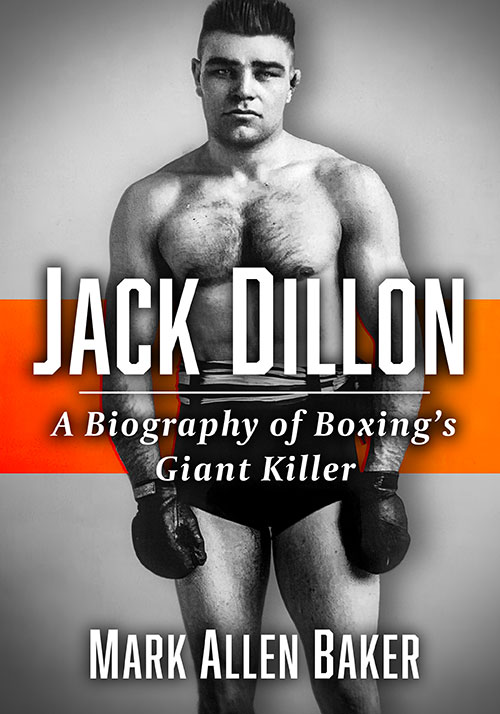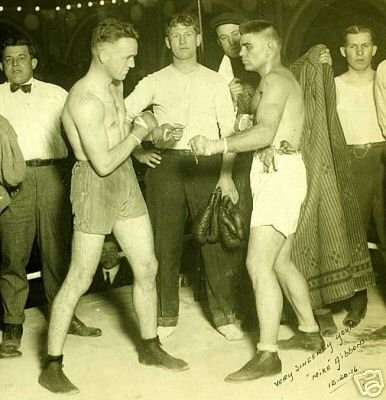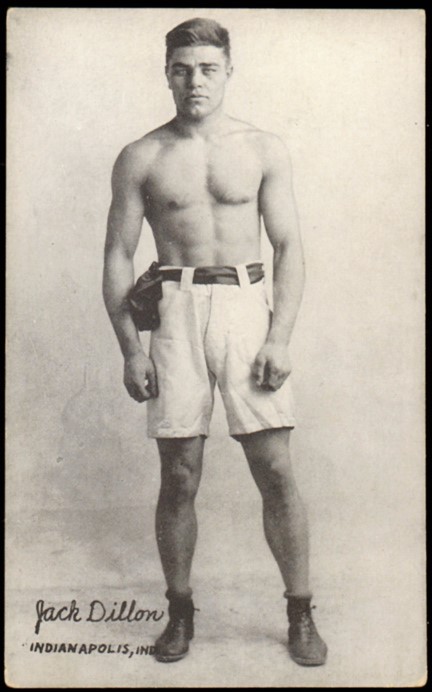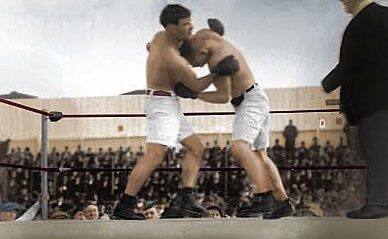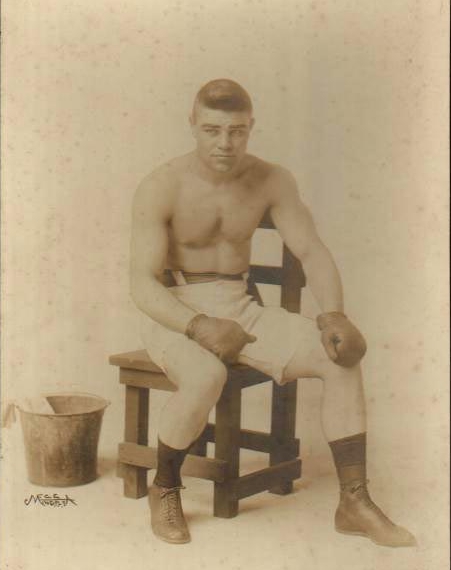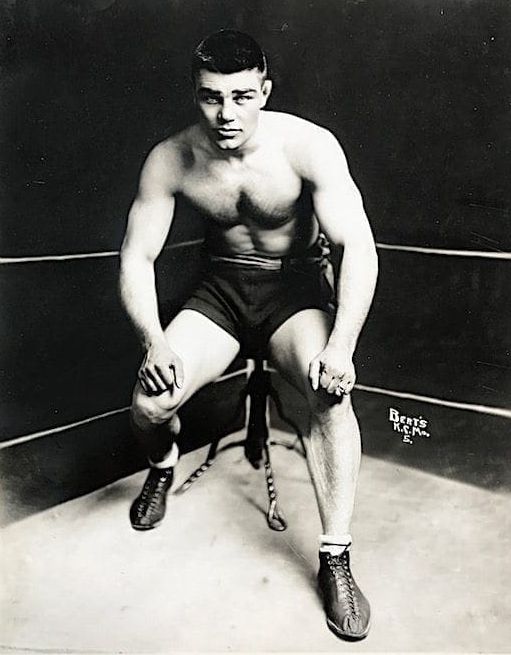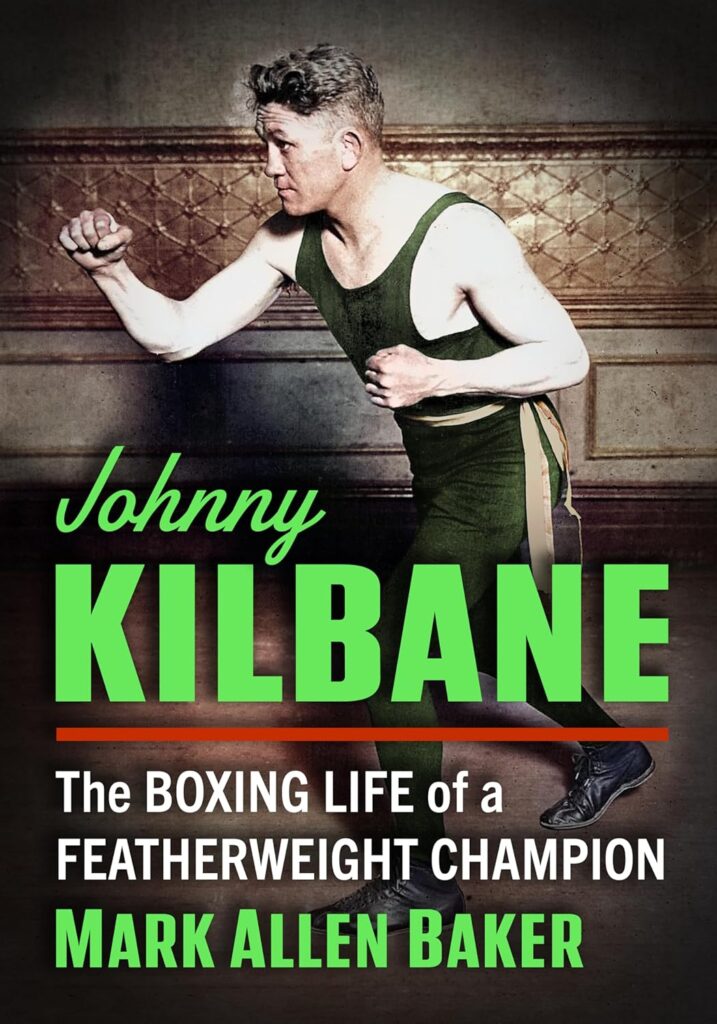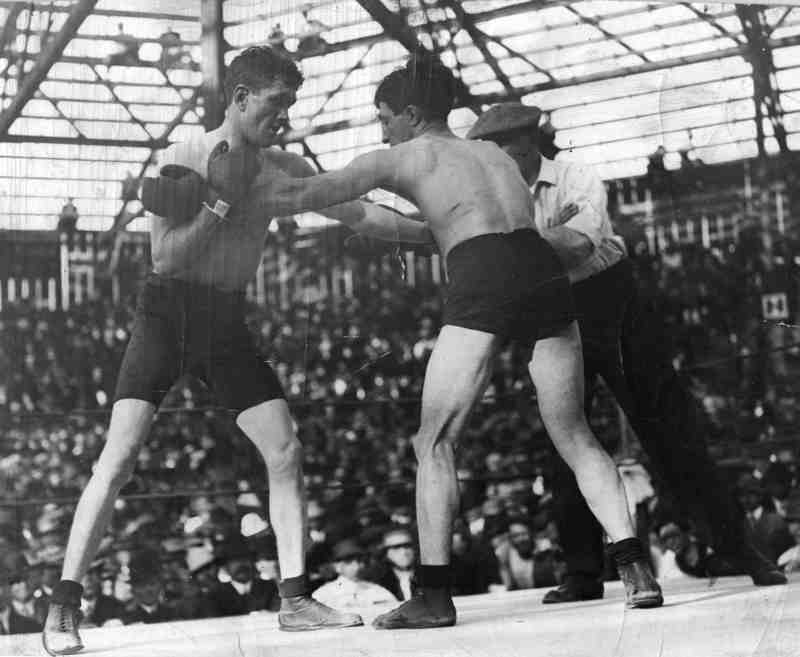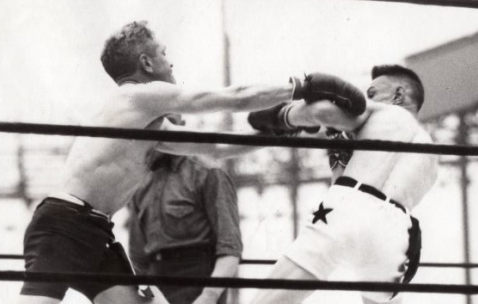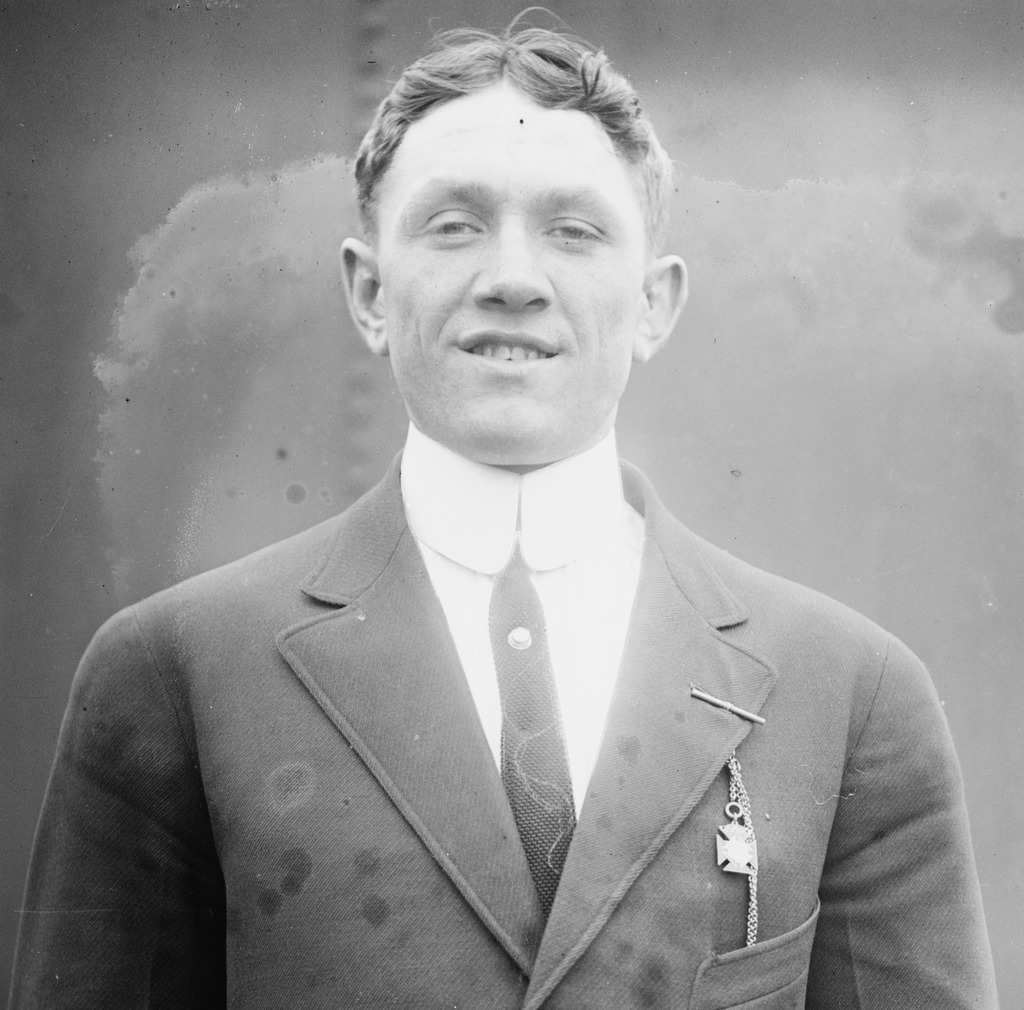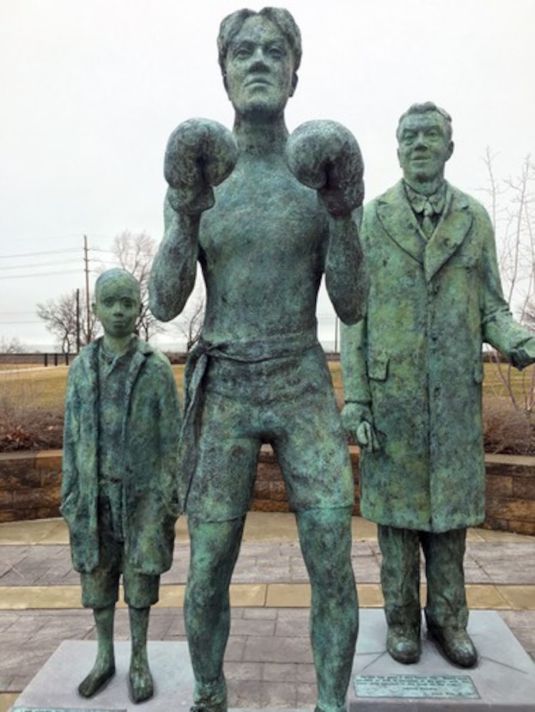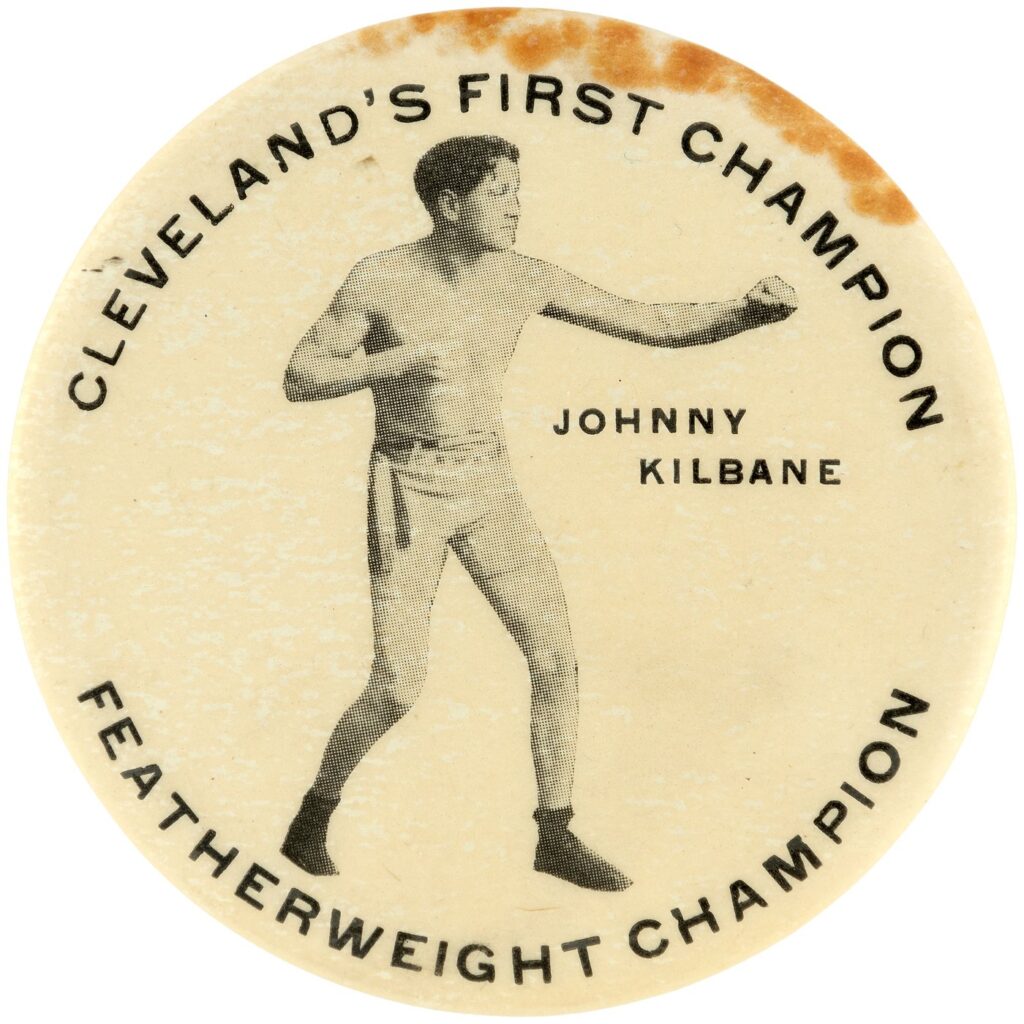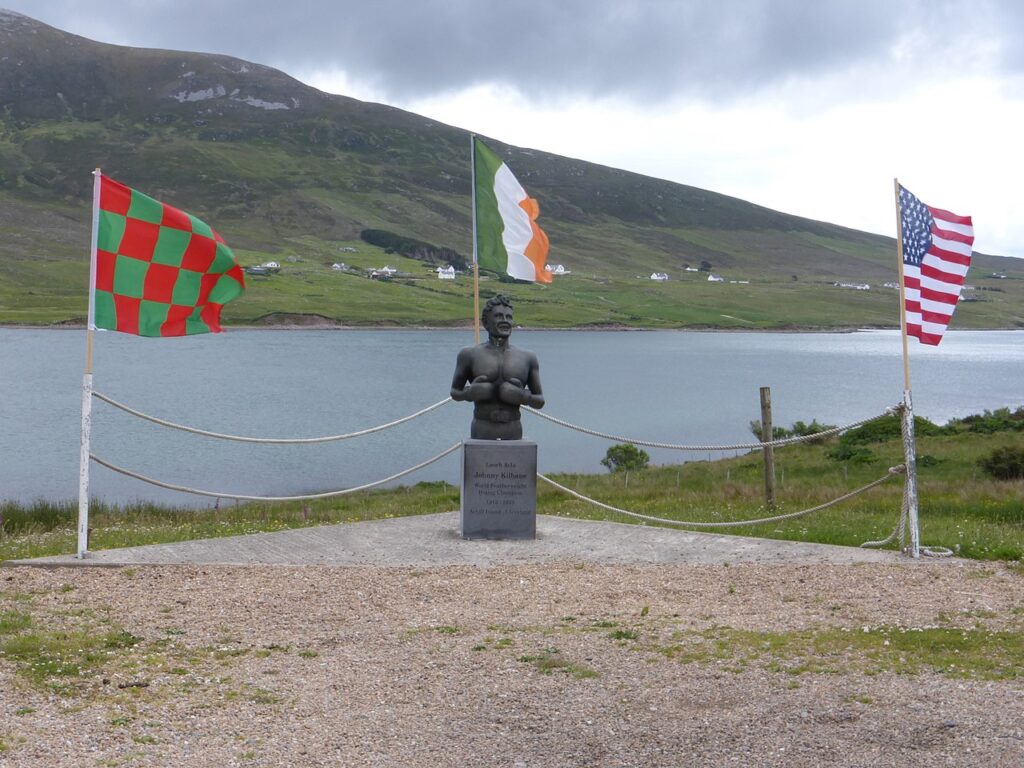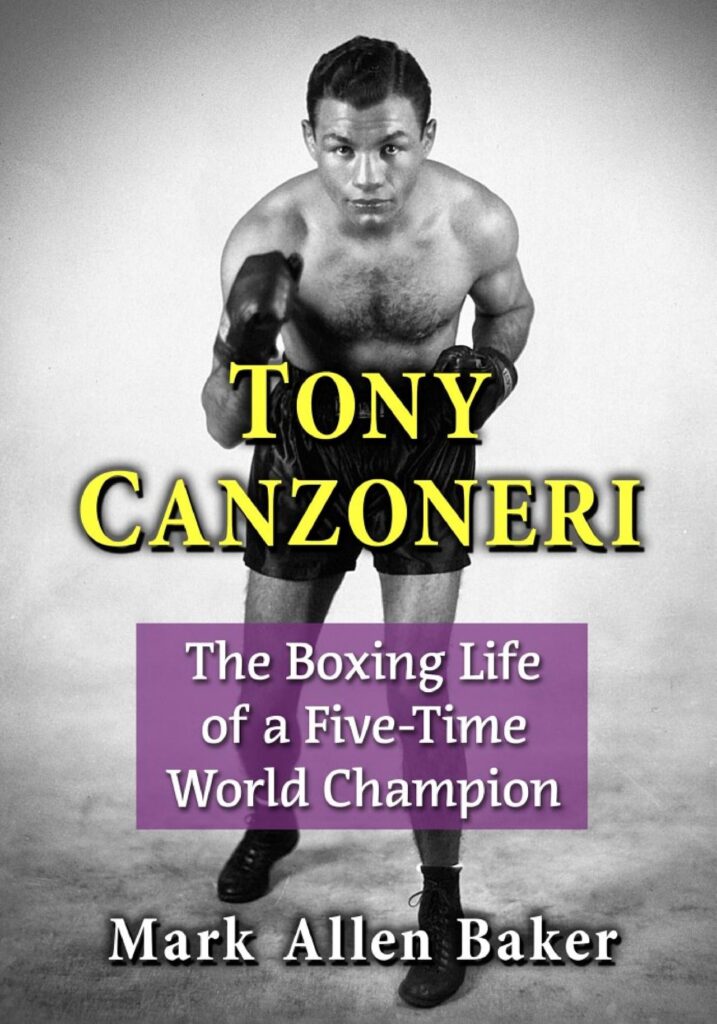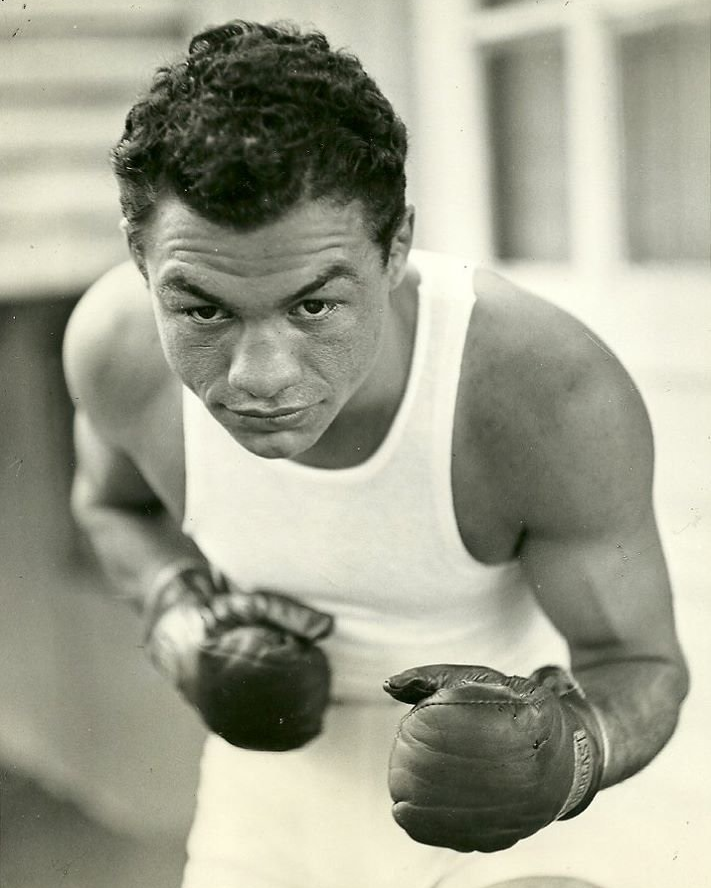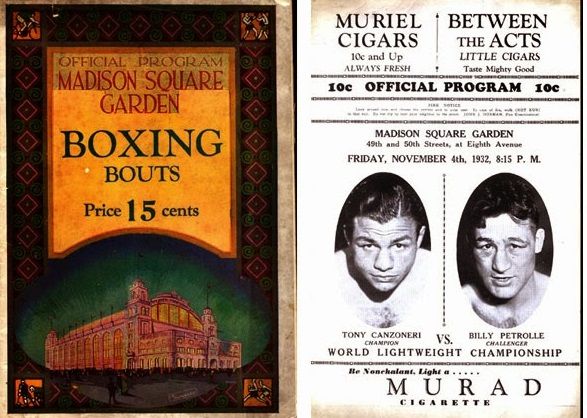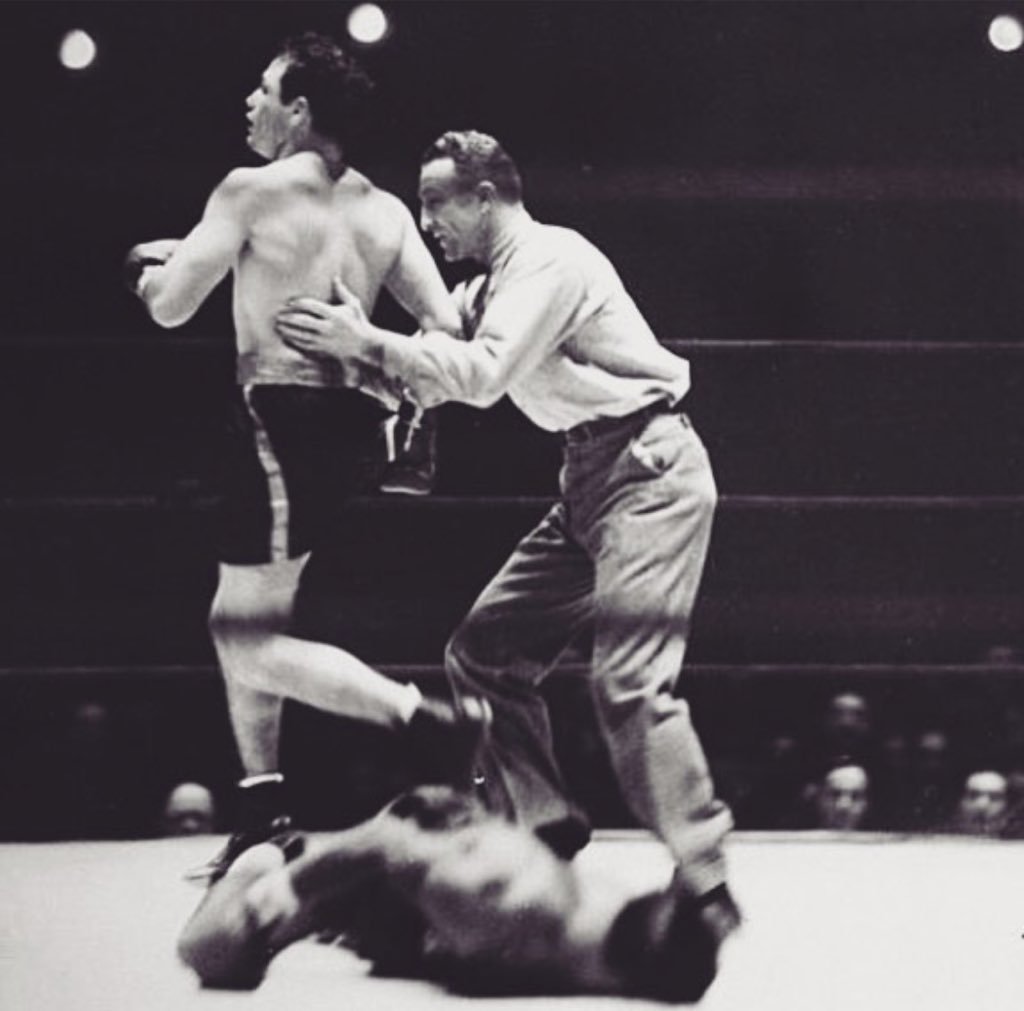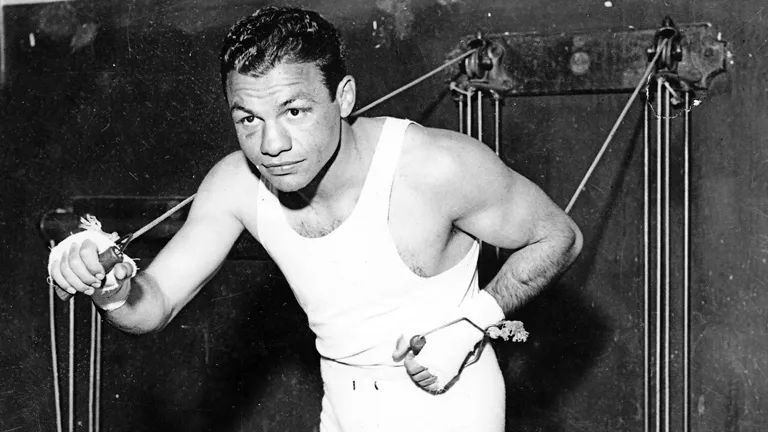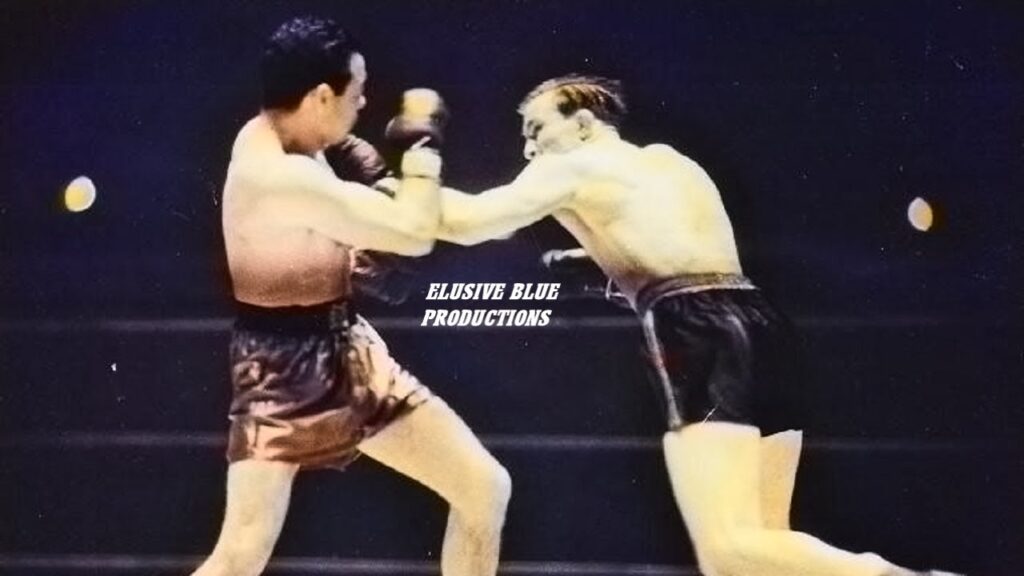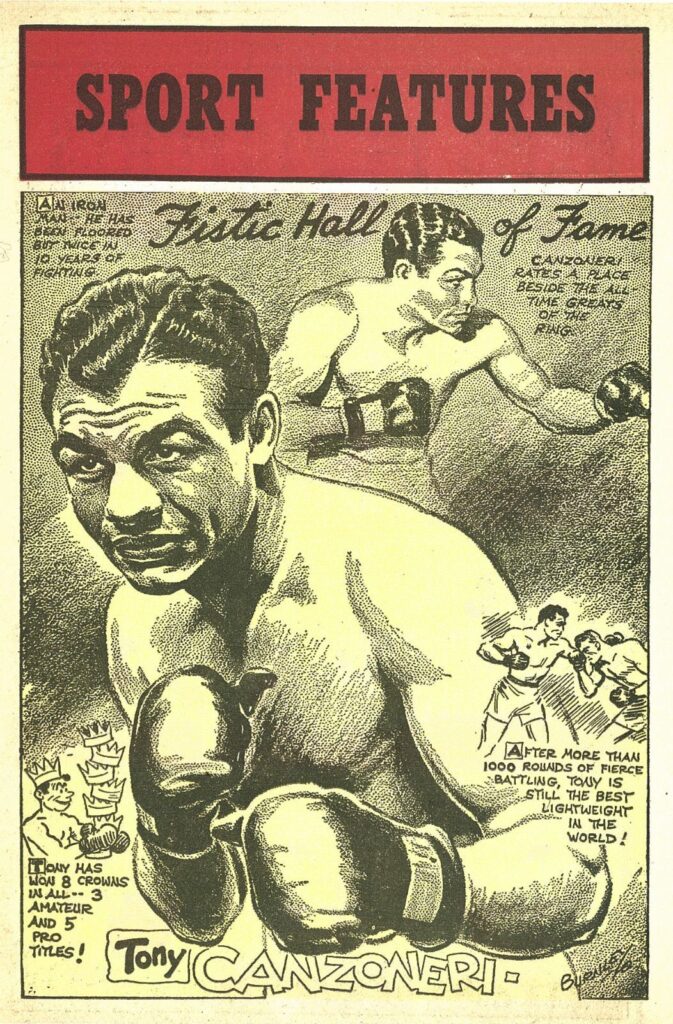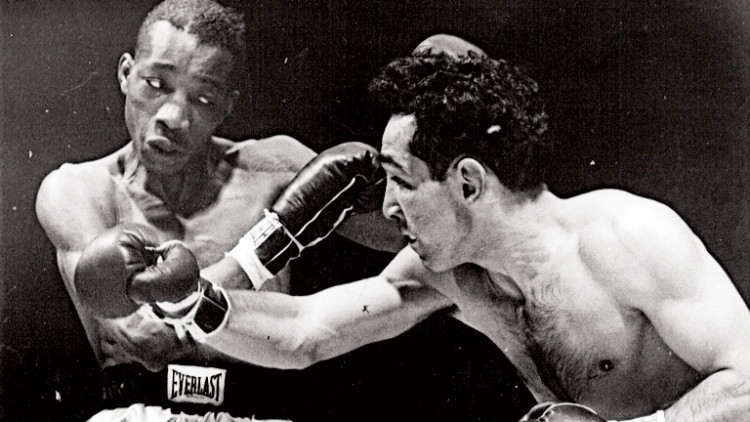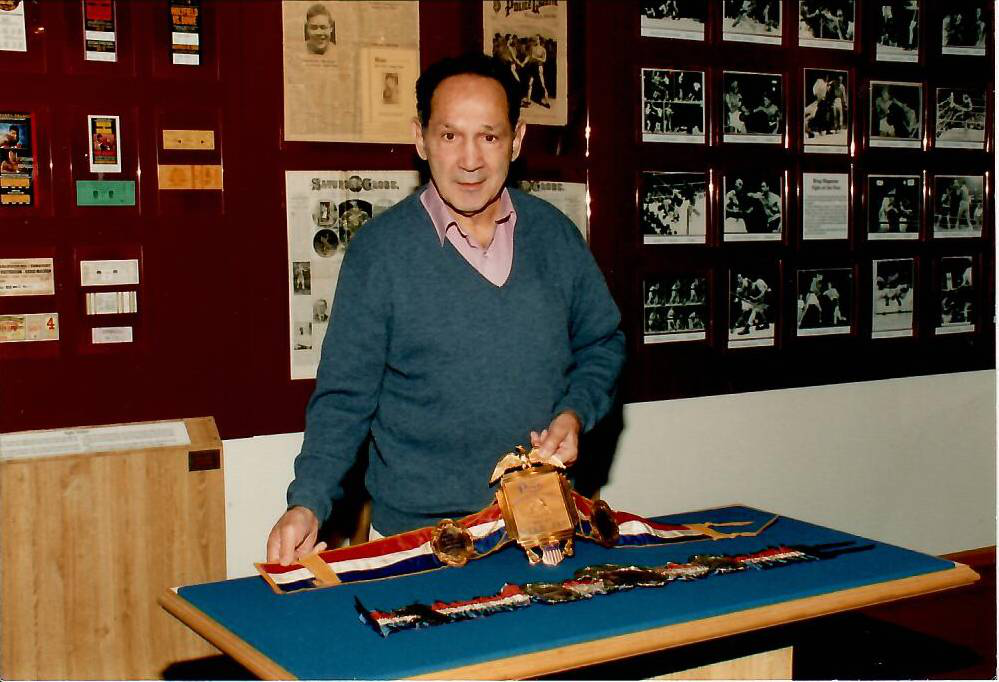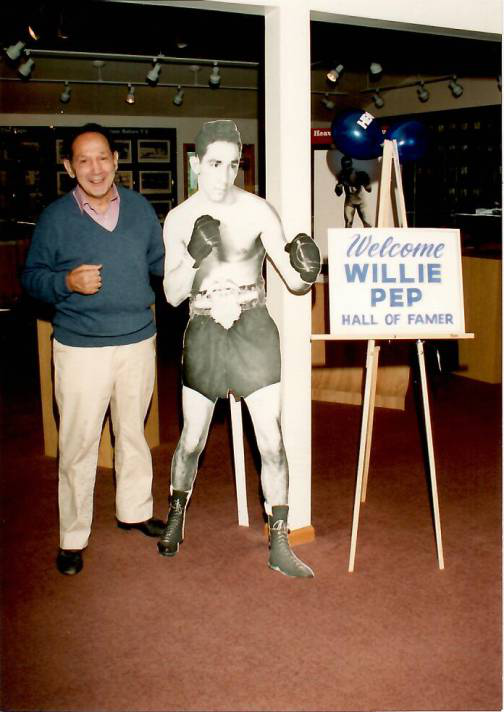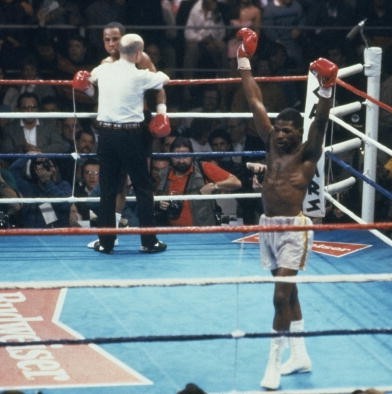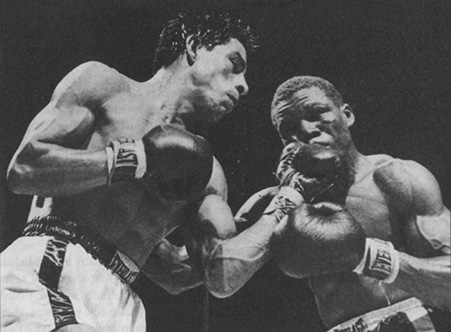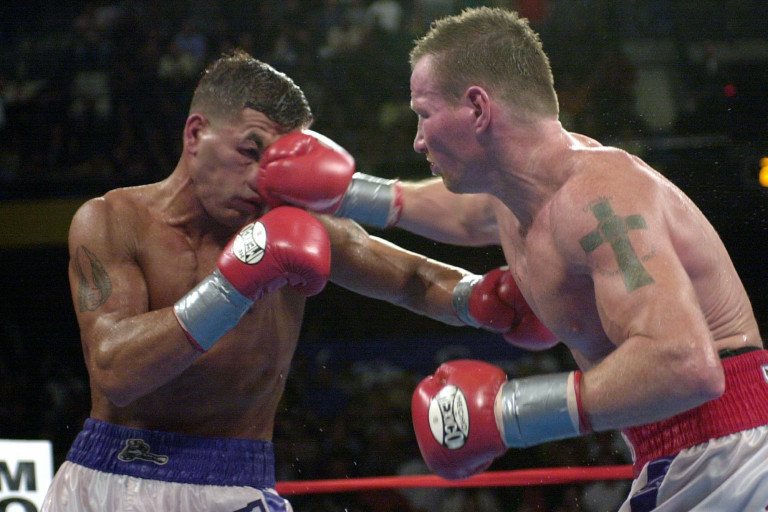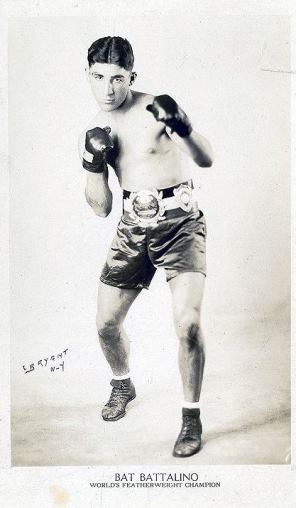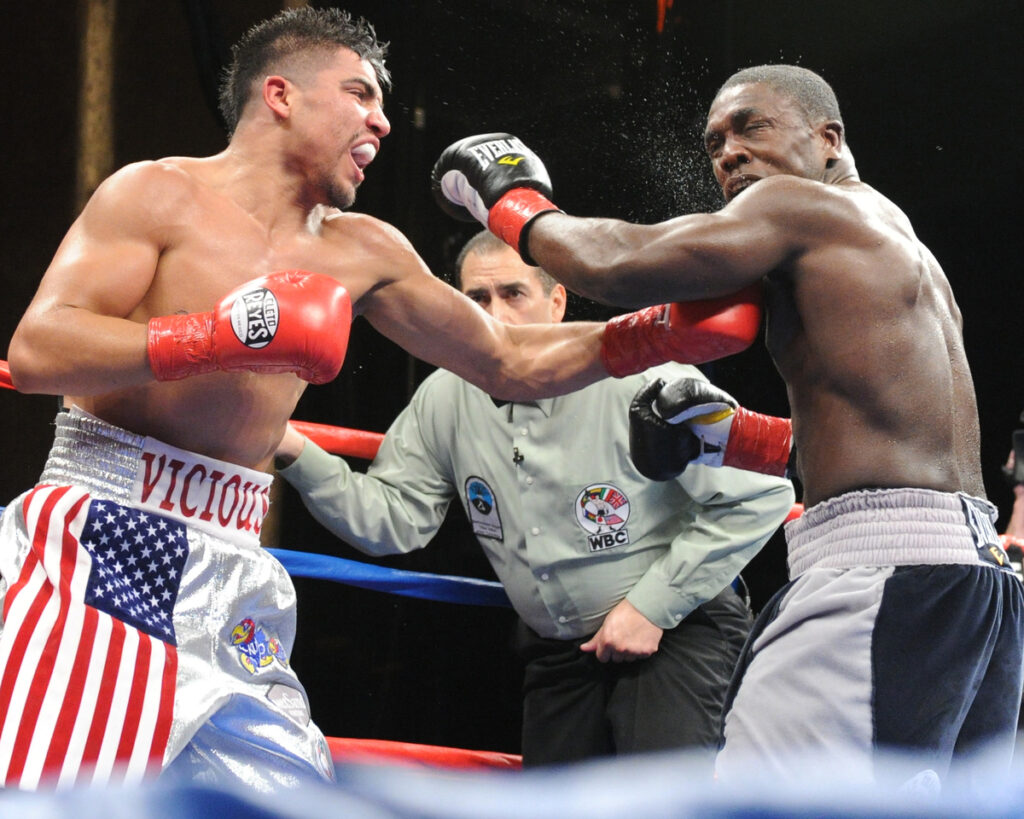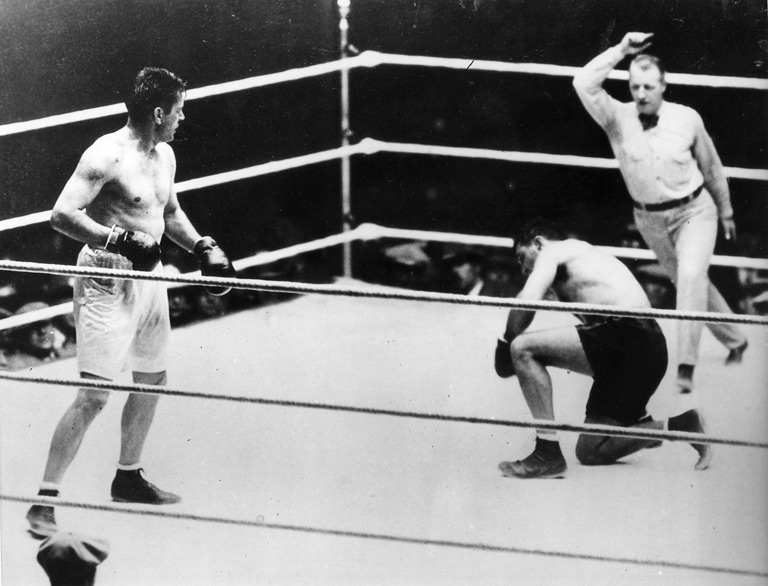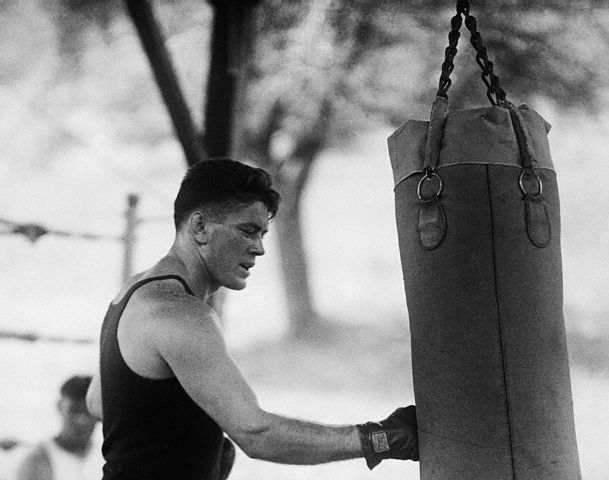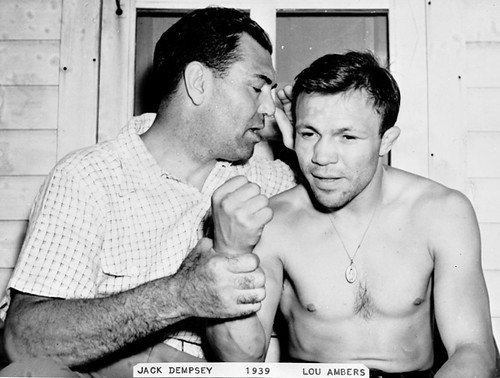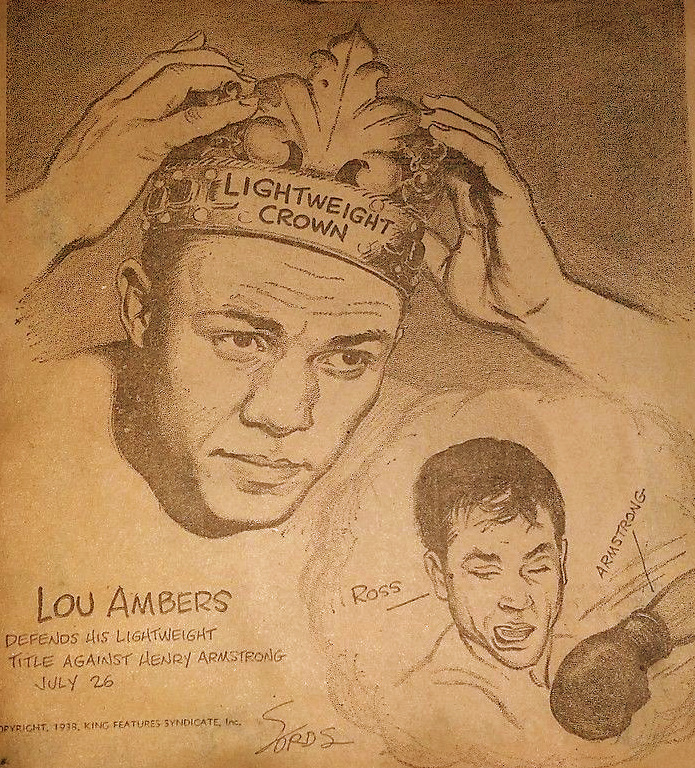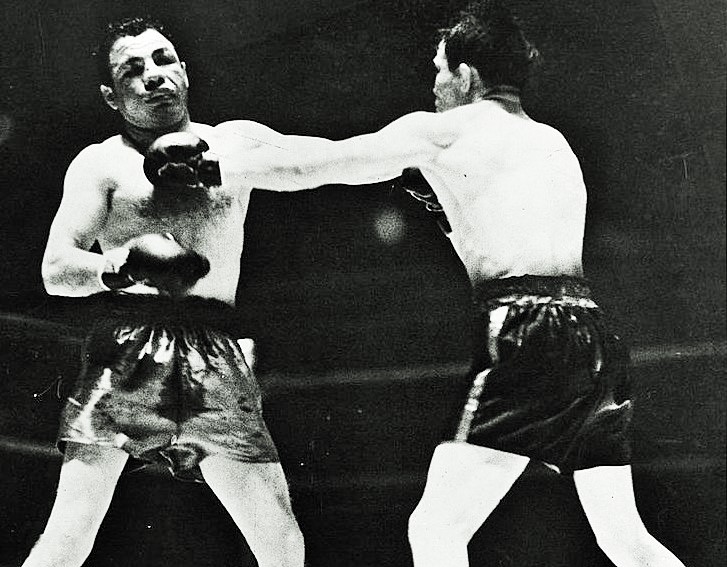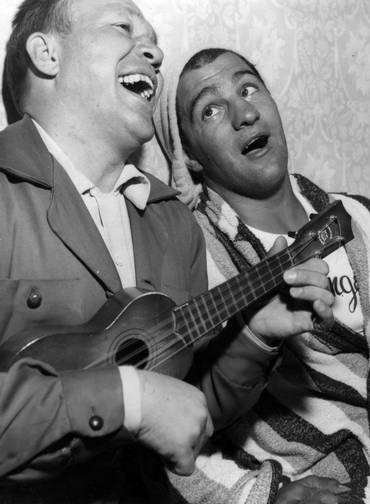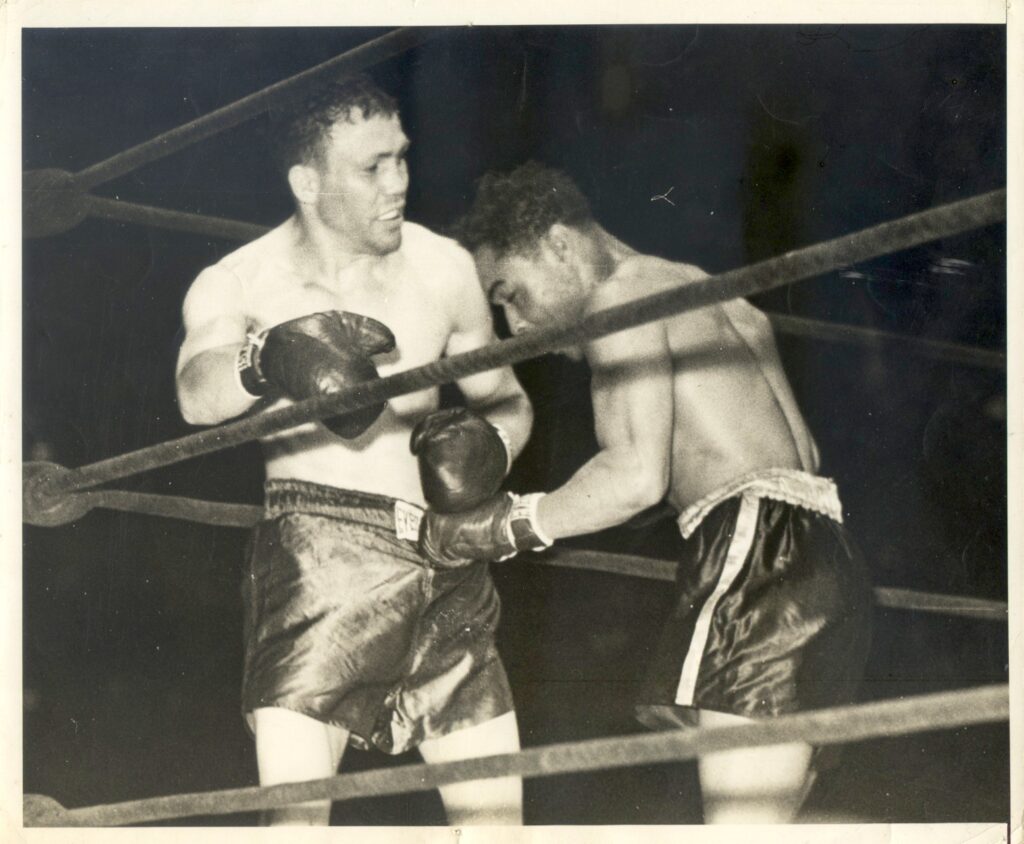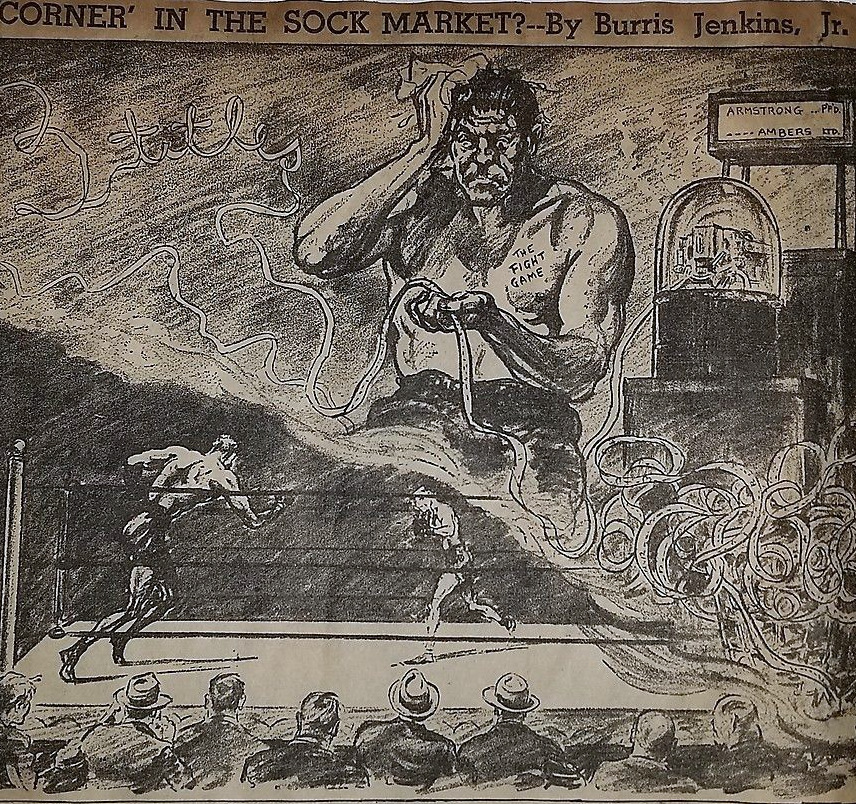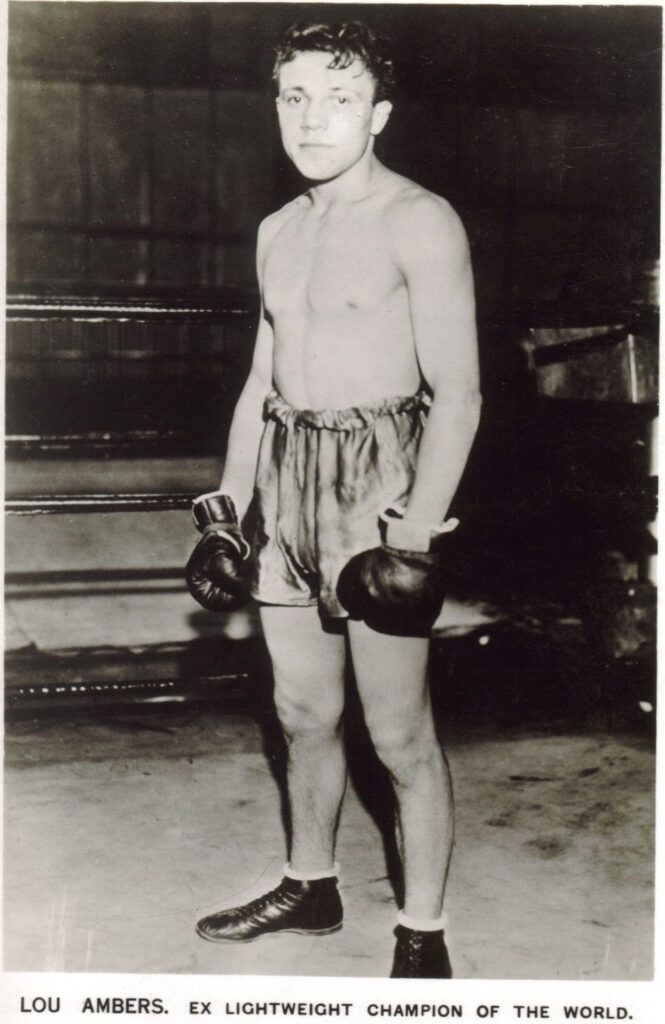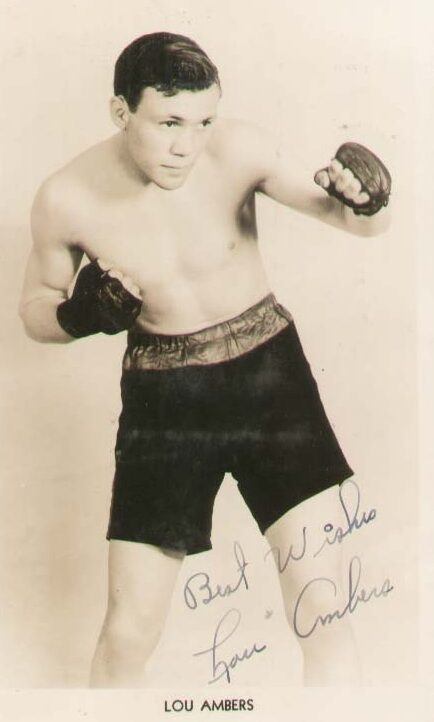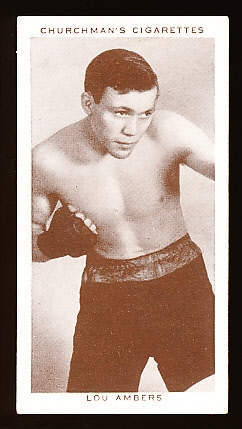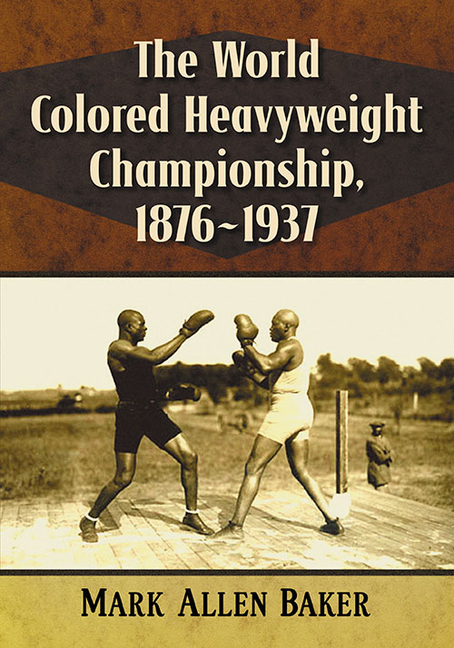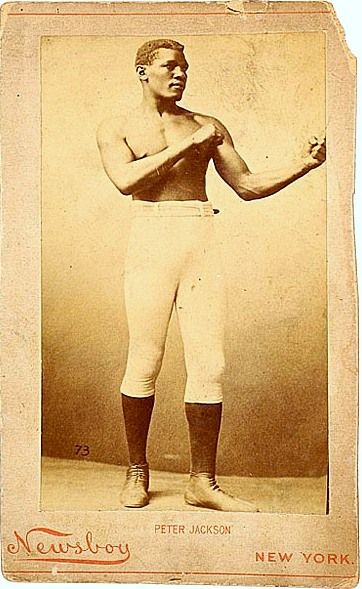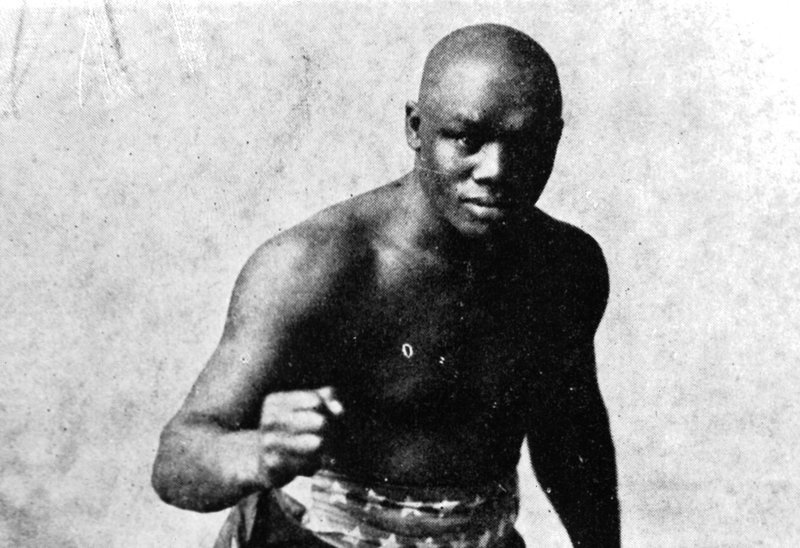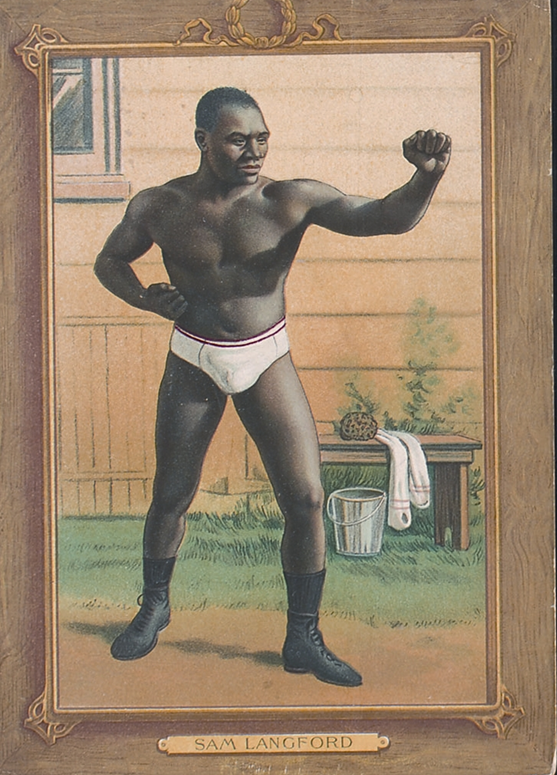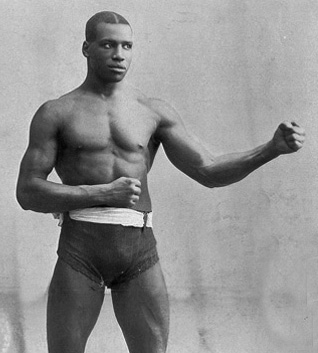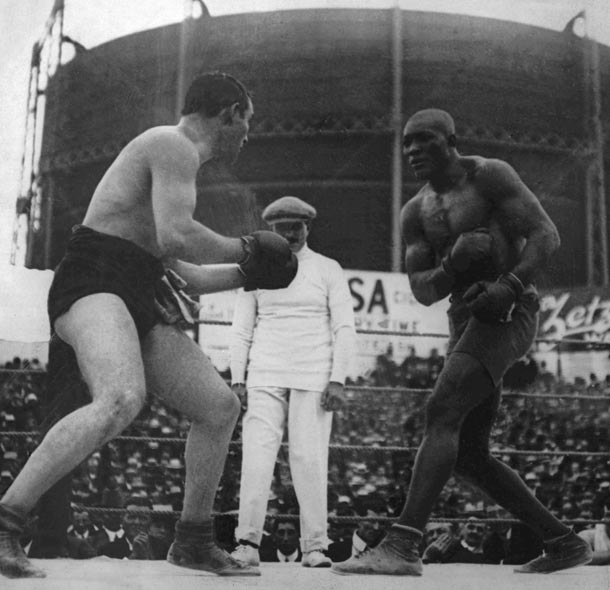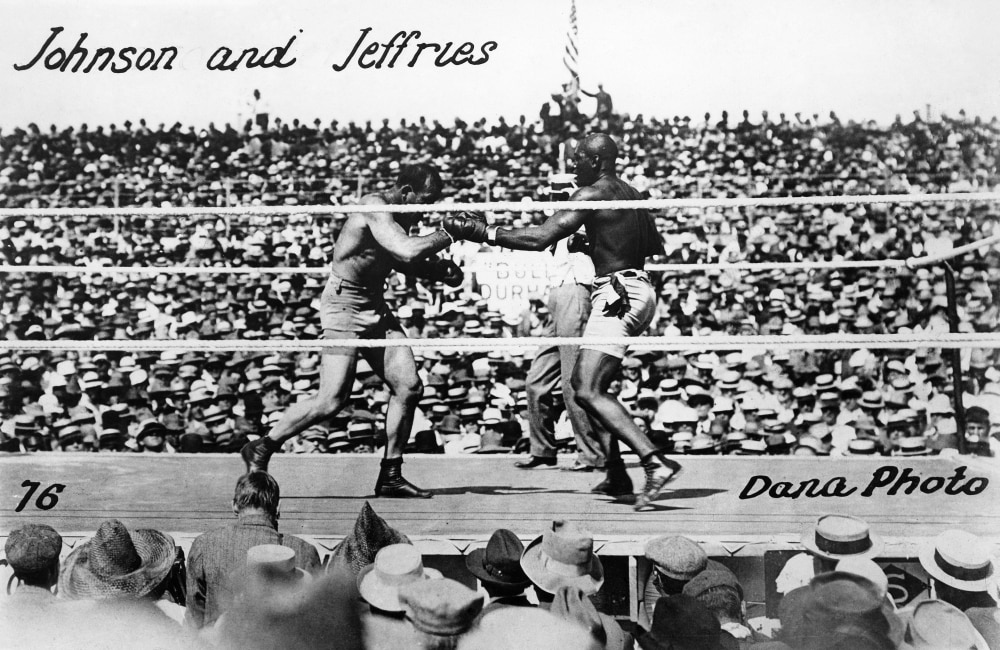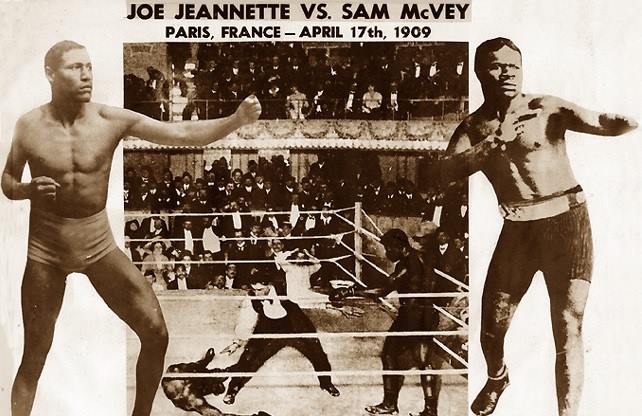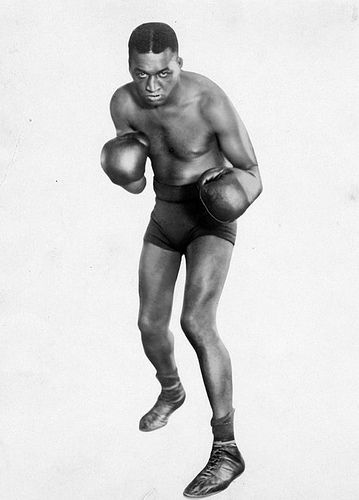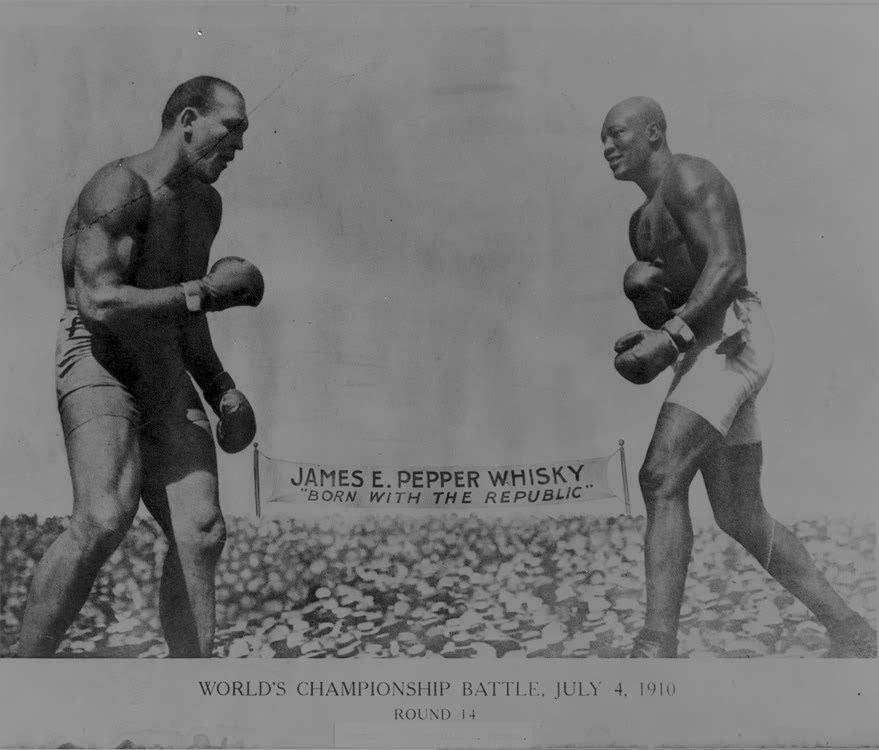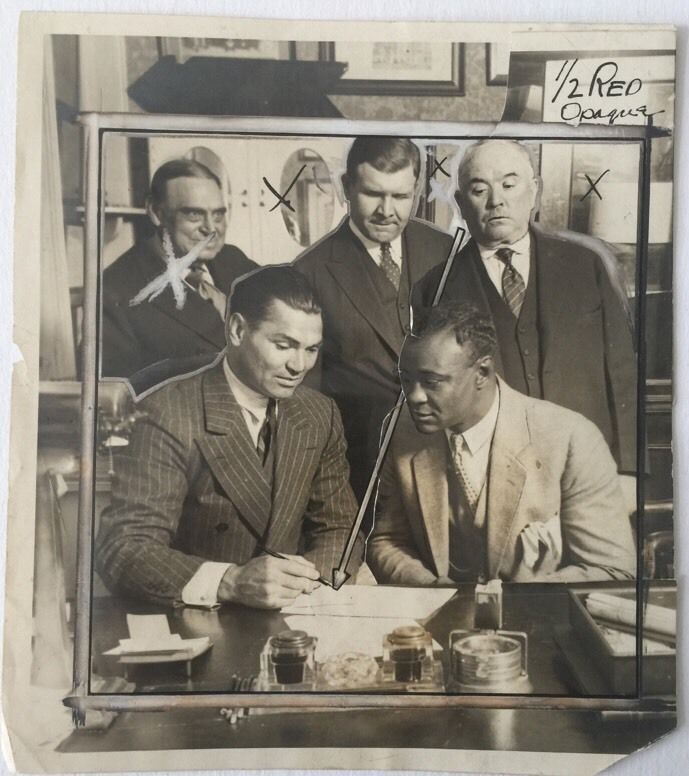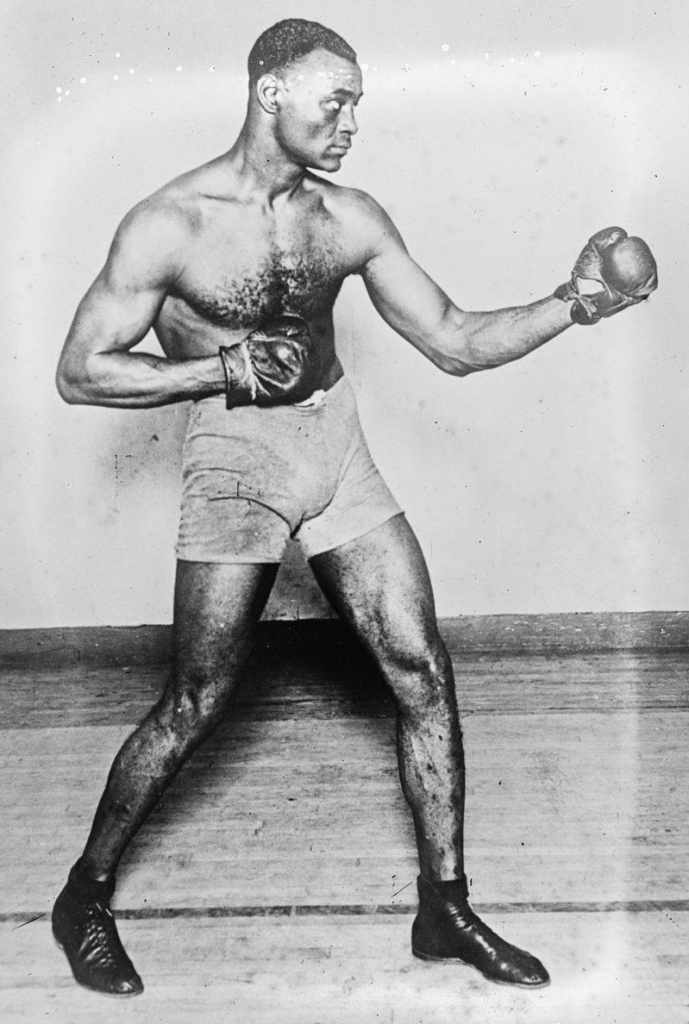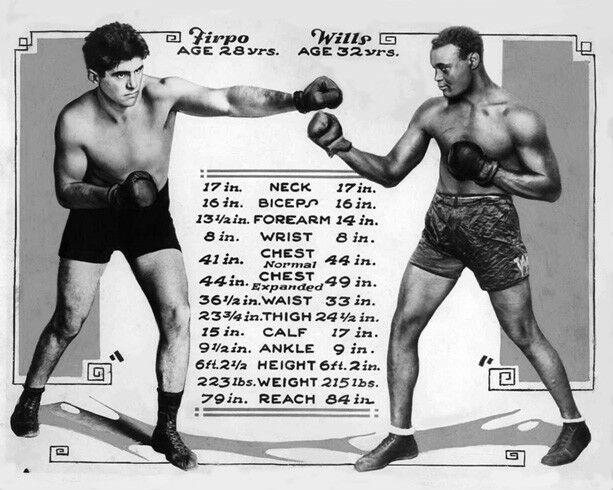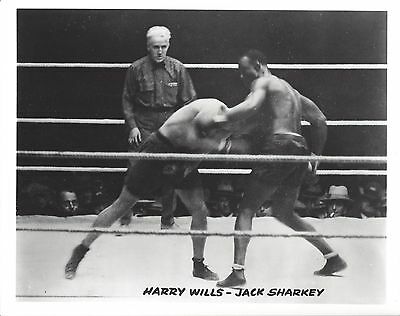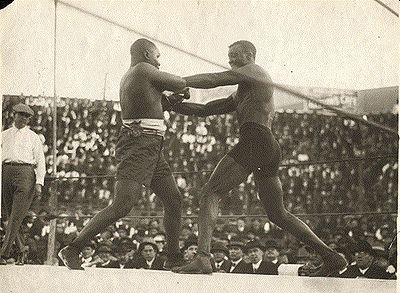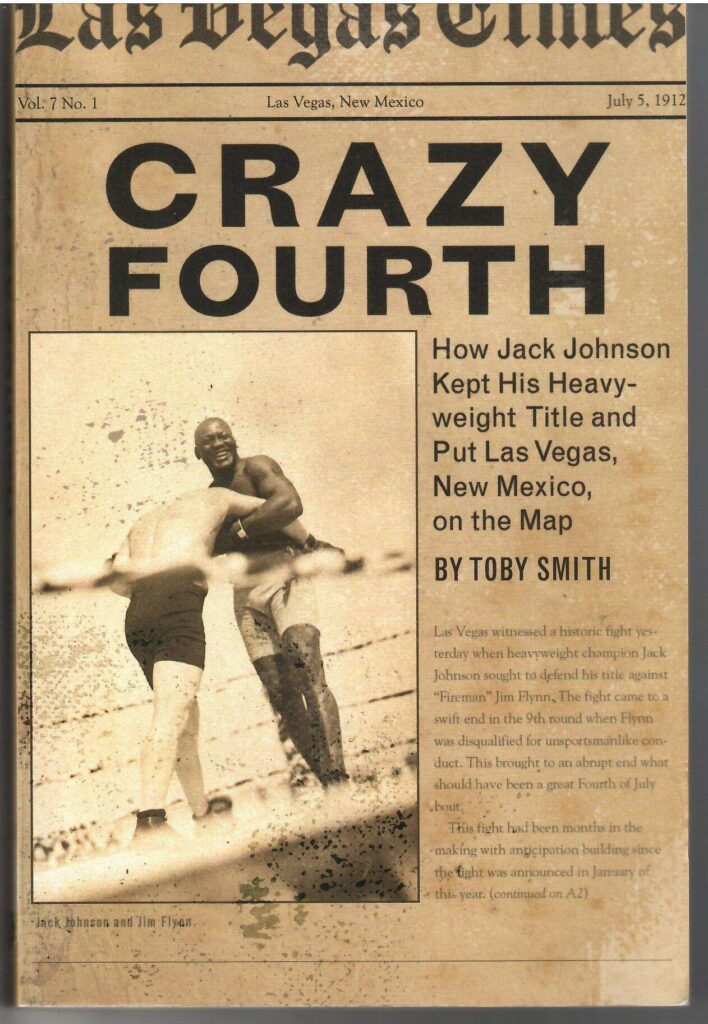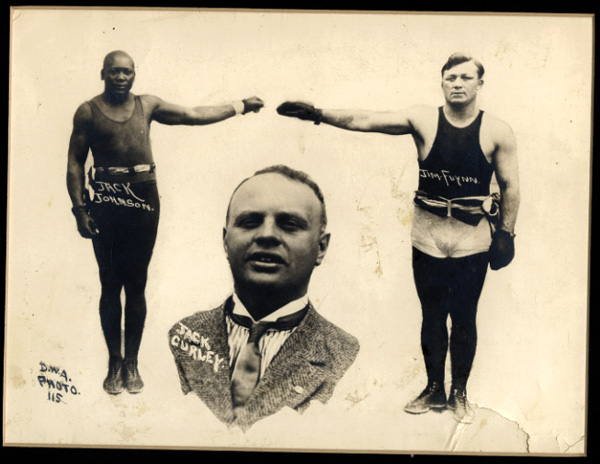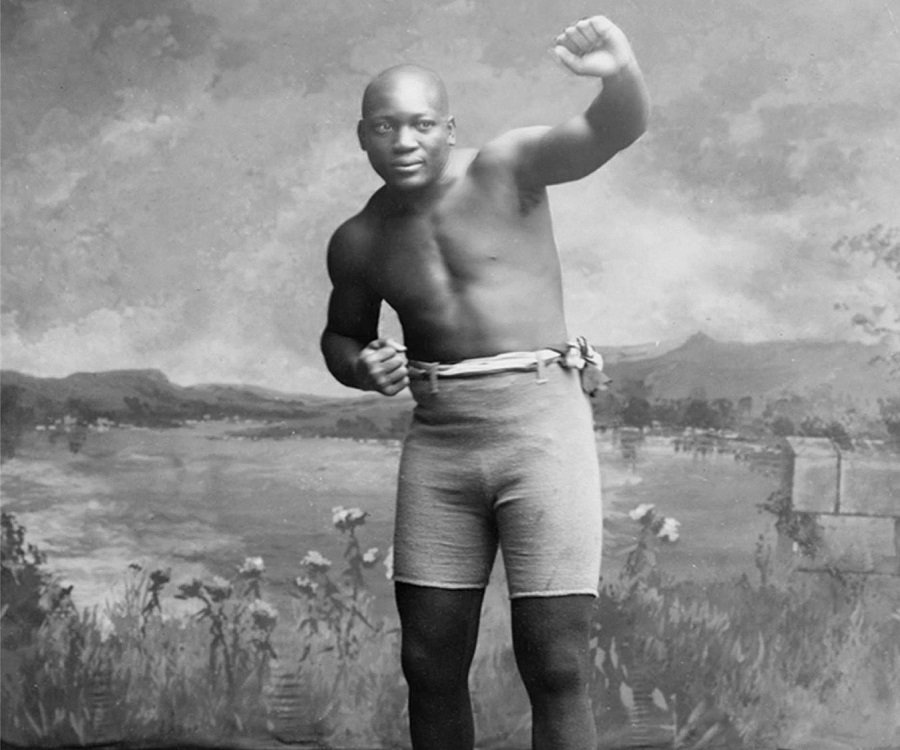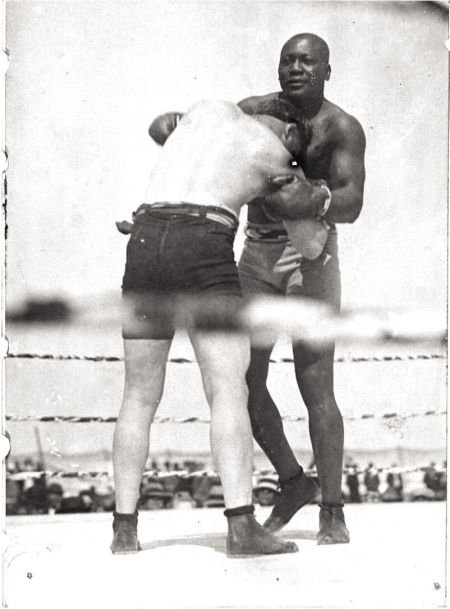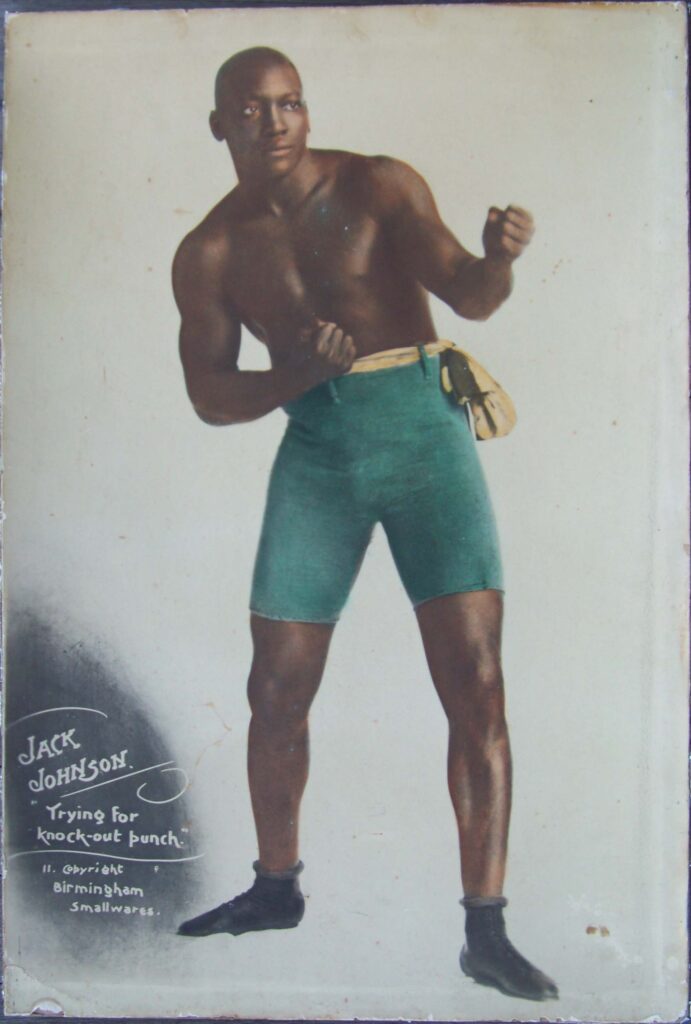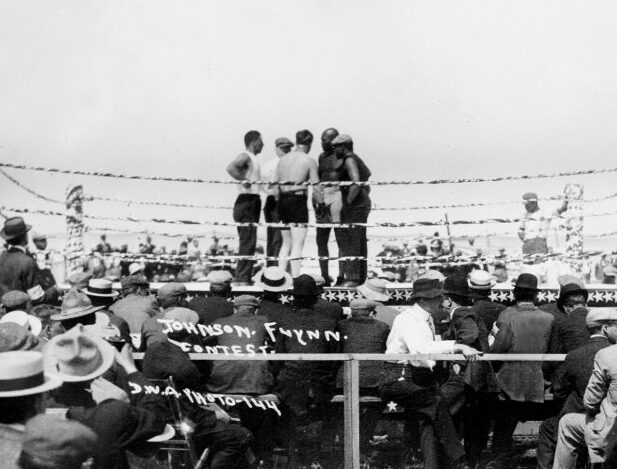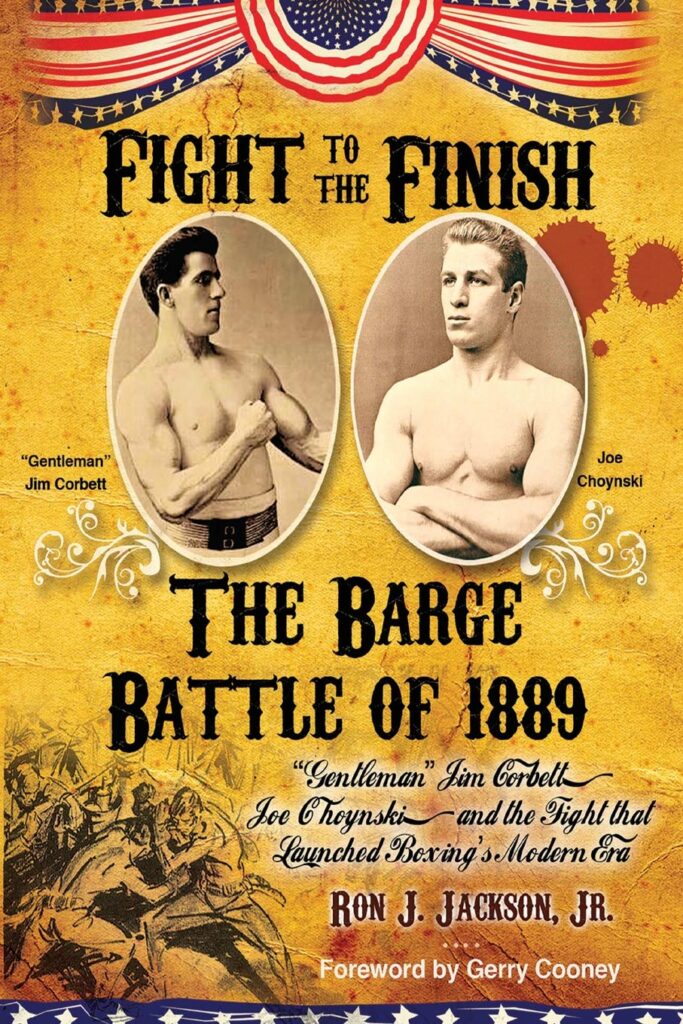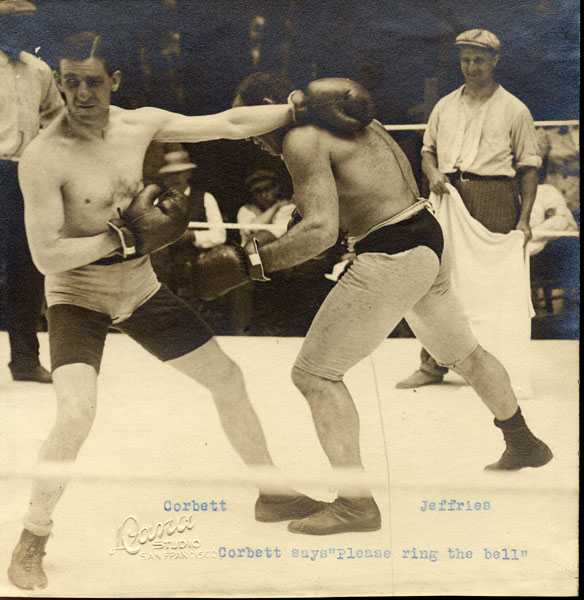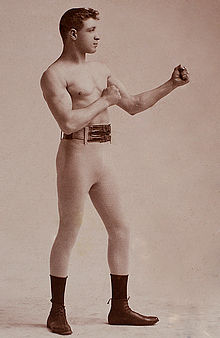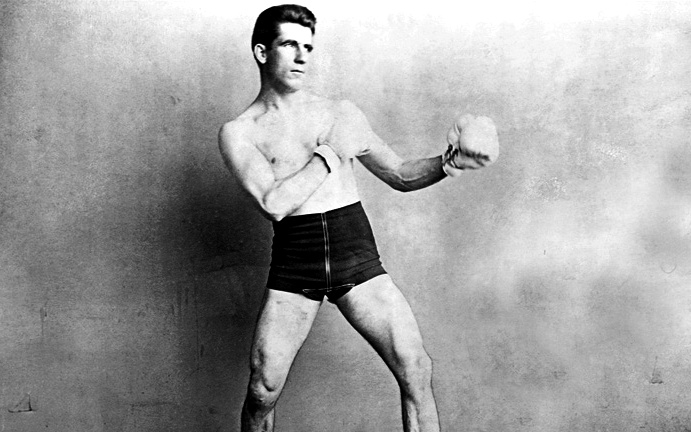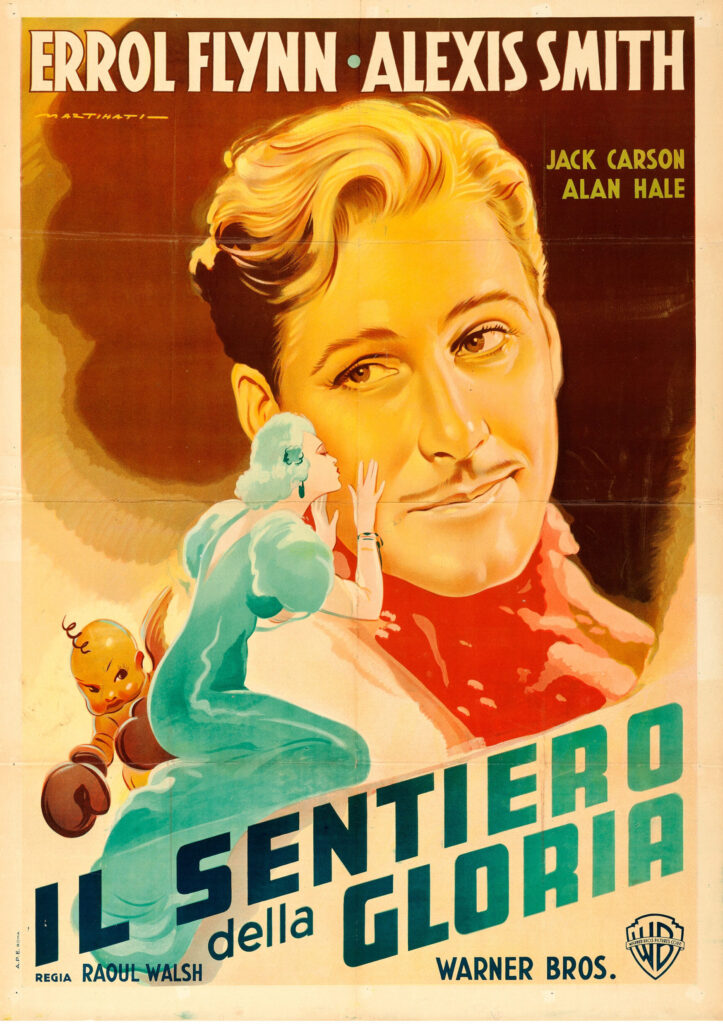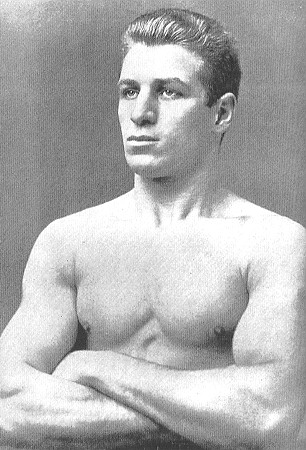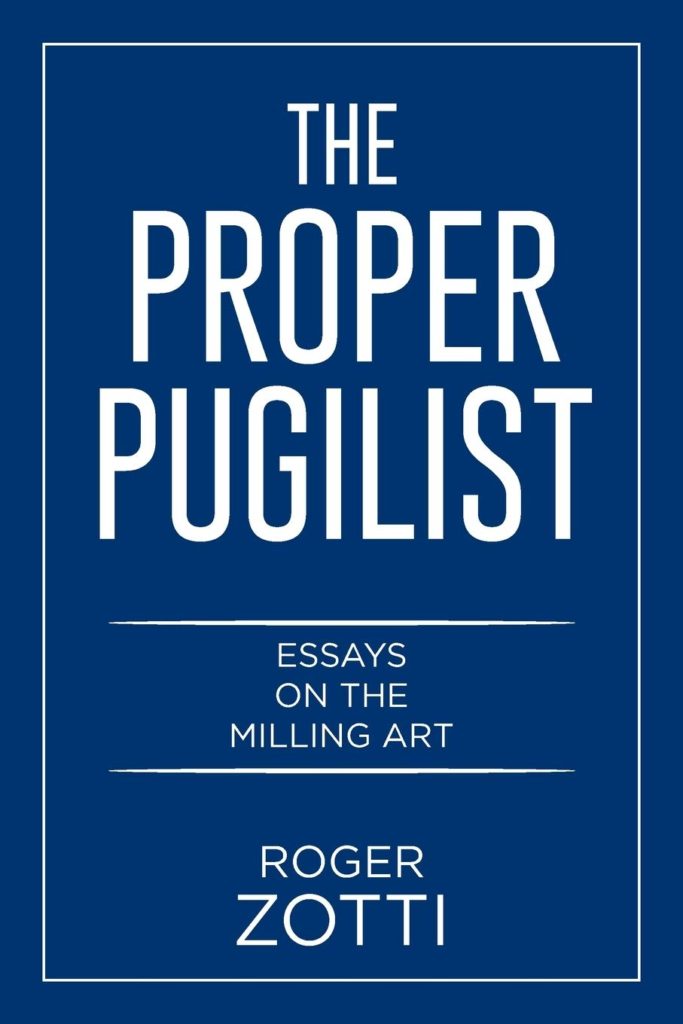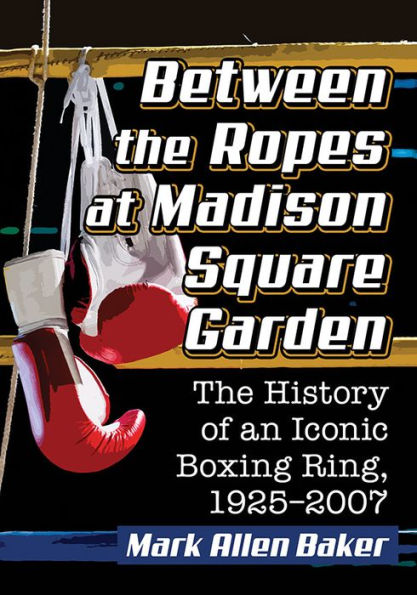Book Reviews
JACK DILLON
A Biography of Boxing’s
Giant Killer
By Mark Allen Baker
McFarland & Company, Inc., Publishers
(www. mcfarlandpub.com) – 217 pp
Reviewed by John Rinaldi and Alex Rinaldi
What better activity to do in the summer than to get comfortable on a beach chair and relax in the blazing sun reading a terrific boxing book. Well, Hall of Fame writer Mark Allen Baker has written the perfect book for that recreation in his latest tale, JACK DILLON – A Biography of Boxing’s Giant Killer.
Mr. Baker has the knack of digging up gold nuggets on long forgotten legendary pugilists and bringing them back to life in flesh and blood exploits in the prize ring of yesteryear.
In his latest book, Mr. Baker unearths the career of former light heavyweight legend Jack “The Hoosier Bearcat” Dillon (1891-1942). Dillon was a leading middleweight prizefighter who defeated Battling Levinsky on a 12-round points decision on April 13, 1914, in Butte, Montana to claim the vacant light heavyweight title.
Mr. Baker has the stratagem for finding subjects that although they were great in their time, their memories have faded like old, yellow newspapers that are now reduced to a pile of disintegrated pulp. Instead of reading the exploits of boxers who have had numerous books written about them, Mr. Baker finds celebrated prizefighters that current boxing fans know little about. We pride ourselves on being historians, but Mr. Baker surprises us day in and day out with new information on former boxing champions in his latest book offerings.
Jack Dillon (born Ernest Cutler Price in Frankfort, Indiana) had a career that spanned 1908 to 1923. Along the way he engaged in 254 bouts, facing the likes of Harry Greb, Tommy Gibbons, Battling Levinsky, Billy Miske, Al McCoy, George Chip, Willie Meehan, Gunboat Smith, Fireman Jim Flynn, Eddie McGoorty, Frank Moran, Frank Klaus, Mike “Twin” Sullivan, and George K.O. Brown, among many others.
In an era of No-decision contests, where it was up to newspaper writers to give a decision, unless a knockout occurred, Dillon engaged in 129 of such bouts. His official record was 94-7-14 (64 KO’s), 129 ND, and 1 NC. At 5 ft. 7 in., Dillon was a stocky, powerfully-built fighter with a relentless, aggressive style, mixed with power in both fists. Dillon took on the best fighters in his day from welterweight all the way up to the heavyweights, which earned him the nickname of “Giant Killer” among the boxing aficionados.
Jack’s most impressive fight was beating heavyweight contender Frank Moran on June 29 in Brooklyn, NY over ten rounds in a No-Decision bout. Moran had previously fought heavyweight champion Jess Willard three months earlier in Madison Square Garden in a 10-round ND bout, where he gave the heavyweight king a tough going. Against the smaller Dillon, Moran took the beating of his life and barely lasted the distance. Mind you, in 1914, Moran battled then heavyweight king Jack Johnson to a 20-round decision loss.
Dillon, who had previously defeated other heavyweight contenders Gunboat Smith and Fireman Jim Smith, was the logical choice for Jess Willard to defend his laurels against. Instead, the lazy champion preferred to join Buffalo Bill’s Wild West Show and make public appearances and exhibitions, instead of facing the dangerous Dillon. Willard would not defend his title until 1919, when he was slaughtered by Jack Dempsey in a blood-soaked Toledo ring.
The failure of luring Willard in the ring was a major disappointment for Dillon, who had the style to give Willard trouble.
Mr. Baker takes the readers on a funhouse ride through the years in arenas all over the country where the courageous Dillon would lace his gloves up against ANYONE who would climb in the ring with him.
The stories of Dillon’s bouts with George Chip, Frank Moran, Battling Levinsky, George Chip and Frank Klaus are simply fascinating.
In his marvelous description of Dillon’s November 10, 1916 fight against Tommy Gibbons in St. Paul, MN, where he was outboxed over 10 rounds, the author added his typically clever remarks, “At the time when Dillon needed to paint a pretty picture, he couldn’t find any brushes. Or maybe he was out of paint.”
Those portraitures are a staple of Mr. Baker’s exuberant writing style.
As usual, the readers will get an abundance of information not only on Dillon, but on all the fighters that squared off against him.
This wonderful book will entertain you during the hot summer months and onwards.
This book is HIGHLY RECOMMENDED!
After reading this book, check out the other enthralling books by Mark Allen Baker that include TONY CANZONERI – The Boxing Life of a Five-Time World Champion, WILLIE PEP – A Biography of the 20th Century’s Greatest Featherweight, Johnny Kilbane – The BOXING LIFE of a FEATHERWEIGHT CHAMPION, The Fighting Times of Abe Attell, LOU AMBERS – A Biography of the World Lightweight Champion and Hall of Famer, The World Colored Heavyweight Championship, 1876-1937, CONNECTICUT BOXING – THE FIGHTS, THE FIGHTERS AND THE FIGHT GAME, Between the Ropes at Madison Square Garden, and Battling Nelson – The Durable Dane.
Mr. Baker’s books can be purchased in paperback and Kindle versions on Amazon, in paperback and Nook Book versions at Barnes and Noble bookstores, Barnes and Noble’s website, and at bookstores around the globe.
__________
McFarland & Company, Inc., Publishers
(www. mcfarlandpub.com) – 203 p
Reviewed by John Rinaldi and Alex Rinaldi
It is the holiday time of the year again. For those looking for that one great book to purchase for the boxing fan in your family for Christmas and Hanukkah, look no further than Boxing Hall of Fame writer Mark Allen Baker’s recent tome, Johnny Kilbane – The BOXING LIFE of a FEATHERWEIGHT CHAMPION.
If one would ask a boxing buff, which fighter held the World’s Featherweight Championship the longest, names like Willie Pep, Sandy Sadler (#4 on list – holding for 6 years, 4 months and 13 days), Salvador Sanchez, Danny Lopez, Alexis Arguello, Kid Chocolate, or Henry Armstrong would pop up, but surprisingly those are all the wrong answers. Instead, clocking in at 11 years, 3 months and 24 days with the World’s Featherweight title belt was Johnny Kilbane. Johnny defeated Abe Attell (#3 on the list with 8 years, 5 months and 19 days) on February 22, 1912, and held on to the crown until being brutally stopped in 6 rounds by Eugene Criqui on June 2, 1923.
In his latest book, Mr. Baker, in his famous explorative narrative, takes the readers from Kilbane’s impoverished background to his rise as one of the highest paid athletes on the planet.
There does not appear to be a sportswriter in the field today who thoroughly researches a subject better than Mark Allen Baker. The author treats his subject as sunken treasure from a long-disappeared pirate ship. Mr. Baker is the diver who repeatedly goes deep into dark waters to excavate whatever nuggets and boxing lore that are available. Once again, with the story of Johnny Kilbane, the readers are presented with a chest full of boxing riches.
Johnny held his title throughout a period where many states had a “No-Decision” law where if the fight did not end in a knockout, the decision would be a no-decision affair, where various newspapers would give their opinion on who was the victor in the fight. What the system did was if a champion defended his title and wound up going the distance, even though he may have clearly lost the fight, he would still retain his laurels on a no-decision.
No-decision bouts were great for fighters like Kilbane, who had a solid jaw and was slick enough to last anywhere from 4 to 10 rounds on his feet to lengthen the time he held his championship. In his career, Kilbane had an incredible number of 78 no-decision verdicts. As is his consummate, investigative style, Baker goes into details of all of the bouts, stating who the press gave the various “wins” to.
Through all the new changes the sport was going through, Mr. Baker writes in a heartfelt way describing how Kilbane persevered in his career, even after experiencing the early death of a beloved young daughter. Johnny was a family man and thought often of his wife and children and, in turn, made his decisions on how best his family can benefit financially from his title reign.
Fights such as Johnny’s battles with the immortal Abe Attell are vividly described in the thrilling pages of this book. For instance, on October 24, 1910, at the Hippodrome in Kansas City, MO, Kilbane met Attell for the first time and lost a 20-round decision. After that loss, Kilbane went on to engage in 16 more fights, including splitting a pair of grueling bouts against the dangerous Mexican Joe Rivers, before finally getting matched again with Abe Attell at the Arena in Vernon, CA.
It is that fight particularly where the Author paints the Kilbane-Attell rematch with such colorful strokes that the fight comes to life in a detailed, thrilling fashion.
Afterwards Mr. Baker gives both fighters’ reactions to the decision. Kilbane remarked, “Attell fought as foul and dirty as a man, well, can and not take an ax! When he saw himself going, he became desperate and fouled me three times – then butted me in the face. His seconds put something on his shoulders and neck, which were intended to make me groggy. I am glad I won the championship, but I am sorry I even entered a fight with a man who would use such tactics.”
“I led the fight all the way and was the aggressor from bell to bell, said the defeated Attell. “If anything, the advantage was in my favor because when I bored in Kilbane was holding me half the time. I felt sure of the decision in case the fight went the limit because I depended on what Eyton (the referee) said. Will I fight Kilbane again? You bet I will. I’ll lick him too if the fight can be pulled off where I can get an even break.”
Although Kilbane and Attell would sign up to fight on three different occasions in 1913 and 1915, the two would never fight again.
Besides the Attell fights, the Author takes the reader on the course and life of the busy champion Kilbane as he faces the likes of Charley White, Johnny Dundee, Knockout Brown, Eddie O’Keefe, Richie Mitchell, George “KO” Chanee and Rocky Kansas.
Of particular interest are the pair of fights against lightweight legend Benny Leonard, who engaged in a 10-round no-decision bout with Kilbane on April 29, 1915, at the Atlantic Gardens in NYC, and their brutal July 25, 1917, rematch at Philadelphia’s Shibe Park, where Leonard KO’d Kilbane in three rounds.
Those are simply graphic and wonderful stories to read. The book contains one fabulous segment after another throughout Kilbane’s fascinating fistic career.
Following his loss to Criqui in 1923, Kilbane ended his career with a 48-6-7-78 ND (24 KO’s) record.
Unfortunately, for many sports heroes at the time, the 1929 Stock Market Crash and subsequent Depression, evaporated most of Kilbane’s ring earnings. Through it all, Kilbane kept his house and possessions, and made a later career by refereeing fights, giving exhibitions, making personal appearances, and engaging in politics. He remained a living legend up until his death in 1957 at the age of 68.
Mark Allen Baker writes wonderfully about a man who was a champion in and out of the ring.
The Author also takes the readers through World War I training camps, where Kilbane was an inspired bayonet instructor for the troops.
Just like other books written by Mr. Baker, once again, a reader will come off an expert of a long-since forgotten battler and time as boxing ghosts from yesteryear jump off the pages to resurrect the exploits of one of the greatest and wily featherweights who ever laced on a pair of gloves.
This enjoyable book is HIGHLY RECOMMENDED and will make a great Hanukkah, Birthday, or Christmas present and
Other outstanding books by Mark Allen Baker include TONY CANZONERI – The Boxing Life of a Five-Time World Champion, WILLIE PEP – A Biography of the 20th Century’s Greatest Featherweight, The Fighting Times of Abe Attell, LOU AMBERS – A Biography of the World Lightweight Champion and Hall of Famer, The World Colored Heavyweight Championship, 1876-1937, CONNECTICUT BOXING – THE FIGHTS, THE FIGHTERS AND THE FIGHT GAME, Between the Ropes at Madison Square Garden, and Battling Nelson – The Durable Dane.
Mr. Baker’s books can be purchased in paperback and Kindle versions on Amazon, in paperback and Nook Book versions at Barnes and Noble bookstores, Barnes and Noble’s website, and at bookstores around the globe.
__________
The USA Boxing News Book Review
TONY CANZONERI
The Boxing Life of a Five-Time World Champion
By Mark Allen Baker
McFarland & Company, Inc., Publishers
(www. mcfarlandpub.com) – 224 pp
Reviewed by John Rinaldi and Alex Rinaldi
Sadly, every day the pages of history of championship pugilists from yesteryear do not just fade away, they disintegrate into a pile of forgotten ashes. The exploits of heavyweight rulers from over 60 years in the past may still be remembered, such as Rocky Marciano, John L. Sullivan, Jack Johnson, Joe Louis, Jack Dempsey, Max Schmeling, James J. Corbett, Max Baer, James J. Braddock, and some others, but epic stories of the title holders of the lighter weights have been relatively obliterated.
Luckily for boxing purists and sports lovers, Mark Allen Baker has a knack and innate talent to somehow resurrect them and pump life into their legends.
One such ring immortal whose story has been reanimated by Mr. Baker for boxing fans of today is Tony Canzoneri. Every time we think we know about a fighter; Mr. Baker gives us hundreds more details that capture the imagination of the reader. In his newest tome, TONY CANZONERI – The Boxing Life of a Five-Time World Champion, the author takes the reader on a fistic journey through the Roaring Twenties and throughout the Great Depression. It is unbelievable that Canzoneri (1908-1959) was not only engaging in professional prizefighter underage, but he was also fighting for a world title when he was only 18! Canzoneri’s first shot at world title honors was when he faced the veteran NBA Bantamweight Champion Bud Taylor on March 26, 1927. Although he lost by a 10-round draw, it was a tremendous fight that Mr. Baker brings to life in the pages of his newest book.
Mr. Baker’s style is that of a literary archeologist as he tirelessly unearths thrilling details that few authors do. Tony Canzoneri has become the latest boxing archeology discovery, like the findings of King Tutankhamun!
Even before we came out with the award-winning publication, The USA Boxing News, we were avid readers of books about the wonderful sport of boxing. So many times, we would read a book and learn very little as the same stories got rehashed again on various fighters and their ring battles, or exciting details were just skimmed over.
Not so with Mr. Baker. When one peruses his works, vast knowledge of the subject is learned. The boundless information is not just focused on the book, in this case the immortal triple champion Tony Canzoneri, but of all the men he encountered in the roped square. Canzoneri faced 18 world champions and nearly every contender from the bantamweights all the way to the welterweights. Names of Billy Petrolle, Kid Chocolate, Barney Ross, Jimmy McLarnin, Lou Ambers, Johnny Jadick, Battling Shaw, Jackie “Kid” Berg, Johnny Dundee, Al Singer, Philly Griffin, Sammy Mandell, Benny Bass, Andre Routis and the aforementioned Bud Taylor are revivified back to life by lightning through the pages of Mr. Baker’s book.
Canzoneri was a masterful boxer who compiled a remarkable 137-24-10 (44 KO’s) record. Unbelievably, Tony was only stopped once in his career, and that was on a third-round TKO by the fists of welterweight KO artist Al “Bummy” Davis in his last fight on November 1, 1939, at Madison Square Garden.
In a book full of highlights, we enjoyed reading Tony’s battles with Jimmy McLarnin, Barney Ross, Bud Taylor and Andre Routis. You can feel the punches landing and hear the crowd screaming with excitement.
Who would have thought that following his esteem boxing career, Canzoneri would become a popular vaudeville and nightclub comic as part of a comedy team with Joey Adams and Mark Plant?
This is the type of book that once you read through it, you will go back and pore over various chapters again and enjoy the prizefighting adventures of Canzoneri.
If you are a boxing fan who yearns to learn something new and enjoy stories of fistic history, this is the book to read. It will also make a great Birthday, Hanukkah, or Christmas present.
This book is HIGHLY RECOMMENDED!
On a personal note, our grandfather Alex Giglia and his brothers Nick Giglia and Charlie Giglia use to frequent Tony Canzoneri’s Bar and Grill and eventually became great friends with him. For years they use to talk about him as one of the greatest fighters they ever saw. One aspect of his bar that they recalled was the huge photo of Canzoneri in his fighting prime that hung in his establishment with the words “This is Me” below it.
Thankfully, Mr. Baker has brought one more great fighter such as Tony Canzoneri back to life.
Other wonderful books by Mark Allen Baker include WILLIE PEP – A Biography of the 20th Century’s Greatest Featherweight, The Fighting Times of Abe Attell, LOU AMBERS – A Biography of the World Lightweight Champion and Hall of Famer, The World Colored Heavyweight Championship, 1876-1937, CONNECTICUT BOXING – THE FIGHTS, THE FIGHTERS AND THE FIGHT GAME, Between the Ropes at Madison Square Garden, and Battling Nelson – The Durable Dane.
Mr. Baker’s books can be purchased in paperback and Kindle versions on Amazon, in paperback and Nook Book versions at Barnes and Noble bookstores, Barnes and Noble’s website, and at bookstores around the globe.
On a side note, we were very touched by the author’s mention of his recently departed brother Matthew Robert Baker. For those who have lost a loved one, it welled our eyes up into tears.
___________
The USA Boxing News Book Review
McFarland& Company, Inc., Publishers – 250 pp
Reviewed by John Rinaldi and Alex Rinaldi
Now that the holiday season has approached us, it is time to search out to find a perfect gift for friends or loved ones. If the intended beneficiary of such a gift is a fan of “The Sweet Science” then look no further than the new book: WILLIE PEP – A Biography of the 20th Century’s Greatest Featherweight by the famed boxing author Mark Allen Baker.
Looking over past book reviews and Mr. Allen’s numerous published works, the author has penned many wonderful texts including, The World Colored Heavyweight Championship, 1876-1937, Battling Nelson – The Durable Dane, CONNECTICUT BOXING – THE FIGHTS, THE FIGHTERS AND THE FIGHT GAME, Between the Ropes at Madison Square Garden, Lou Ambers, and The Fighting Times of Abe Attell.
Besides the current book, the others mentioned would also make wonderful holiday presents.
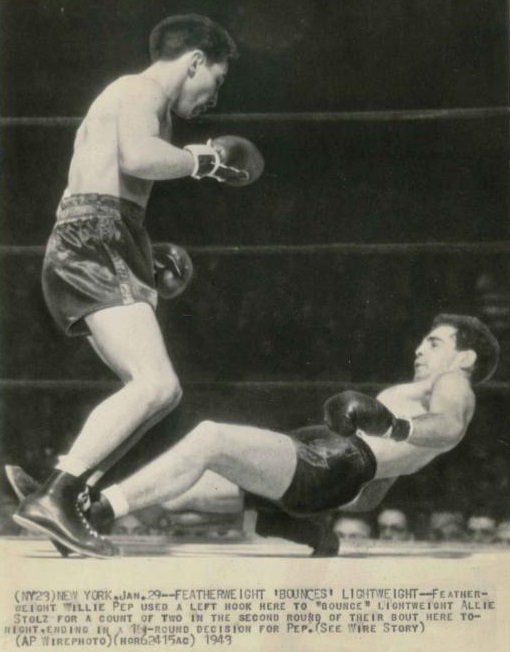
Featherweight king Willie Pep -L- floors top lightweight contender Allie Stolz -R- in their January 29, 1943 bout in MSG. Pep won a 10-round decision.
Before even flipping a page, a book on Willie Pep already piqued our interest since we are big fans of the immortal 2-time featherweight king. Through our past positions as Board Members of The International Boxing Hall of Fame and roles as Vice President and Secretary for a few terms, we had the wonderful opportunity to meet Pep numerous times between 1990 and 2000. Not only was the featherweight legend friendly with the press, but he was amazing in dealing with the boxing fans who would make the yearly pilgrimage to Canastota, New York to attend the annual Boxing Hall of Fame Induction ceremony.
All through these years, Willie never tired of greeting the fans, posing for photographs, and signing thousands of autographs. He seemed to enjoy the admiration and always treated the fans with a smile and a funny comment. He was simply a great guy.
In addition to being fans of the Will o’ the Wisp, the founder of our publication, The USA Boxing News, Joseph Rinaldi, was a huge admirer of Pep and his ring exploits. In fact, Joseph Rinaldi was one of the 19,097 fans who packed Madison Square Garden on February 11, 1949, to witness Willie Pep regaining his featherweight title over the legendary Sandy Saddler by a unanimous 15-round decision. That battle was arguably one of the greatest fights of all time, and probably Pep’s finest performance.
In glorious detail, Mr. Baker takes the readers back to Yesteryear at a ringside seat to that fight, along with numerous other bouts. The author gives such vivid accounts of Pep’s battles, so much so, that the reader can literally hear the thump of the punches landed in those contests.
While many consider us to be top-level boxing historians, Mr. Baker still repeatedly educates us with information that we never knew before.
We cannot think of one author out there who researches a subject as diligently as the author does. Not only is his narrative absorbing, but his footnotes alone make for additional compelling reading.
Willie Pep has been the subject of many books over the past 70-plus years, but never has his ring accomplishments been burned into the pages better than Mr. Baker’s work. If one had not been impressed with Pep’s amazing career before reading this text, then after reading, there will be further acclaim of Willie “Will o’ the Wisp” Pep.
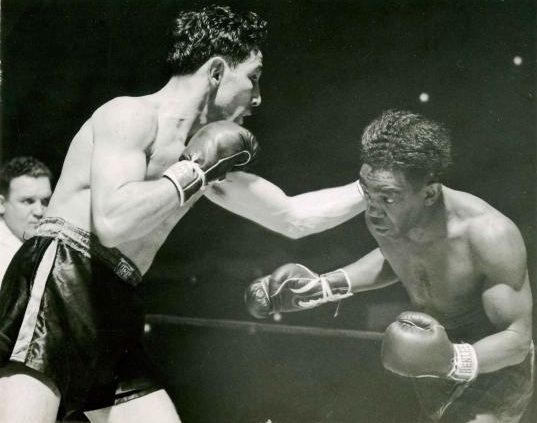
Featherweight champion Willie Pep -L- vs. ex-champ Chalky Wright -R- in their 1944 rematch won by Pep.
Over a professional career that began on July 25, 1940, and ended with his final bout on March 16, 1966, Pep amassed an incredible record of 229-11-1 (65 KO’s), and Mr. Baker brings his readers to every ring contest. Not only does the author give a vivid account of Pep’s bouts, but also informs the readers of each of Willie’s opponents. So instead of just giving the outcomes of each ring meeting, there is a plethora of information regarding Willie’s foes.
Mr. Baker is always one to bring up details that are unexpected. One such account occurred on October 1, 1965, on a fight card promoted by Hall of Famer Don Elbaum at the War Memorial Arena in Johnstown, Pennsylvania. The card featured not only Pep winning a third-round TKO over Willie Little, but also was topped by the immortal Sugar Ray Robinson beating Canadian Welterweight Champion Peter Schmidt on a 10-round decision. Although both legends were in the twilight of their respective career, it was still a promotion featuring both Willie Pep and Sugar Ray Robinson, arguably two of the greatest fistic immortals of all time! Surprisingly, only a small crowd of 1,600 fans turned out. What a shocker! You can fill a stadium today to watch those two pugilistic greats perform in the ring, no matter what stage of their careers.

Willie Pep -L- attacks Featherweight Champ Chalky Wright -R- on his way to winning the title on November 20, 1942.
There are even more nuggets, such as Pep’s survival from an airplane crash on a late Sunday night on January 5, 1947, in a wooded area near Vineland, New Jersey. The crash killed 3 people and wounded 20 others. Miraculously, Pep only suffered a broken leg and two chipped and split vertebrae. Even more of a wonderwork was that Pep returned to the ring six months later on June 17 and defeated Victor Flores at the Hartford Auditorium’s outdoor arena on a 10-round decision – winning all ten rounds! Pep then goes on to his regular fight every ten days schedule. What a remarkable fighter!
The author takes the readers through Pep’s childhood, his sensational amateur career, and his march to the World’s Featherweight Championship. From his victory over Featherweight title holder Chalky Wright on November 20, 1942, until his dethronement at the mighty fists of the immortal Sandy Saddler on October 29, 1948, and onwards through three more battles against the dangerous Saddler and so forth, Willie Pep’s gutsy fortitude and immense talent shines brightly through the pages.
We did not think it could be possible, but Mr. Baker outshines himself with this marvelous book on the incomparable Willie Pep.
This book is HIGHLY RECOMMENDED for SUPER READING!!
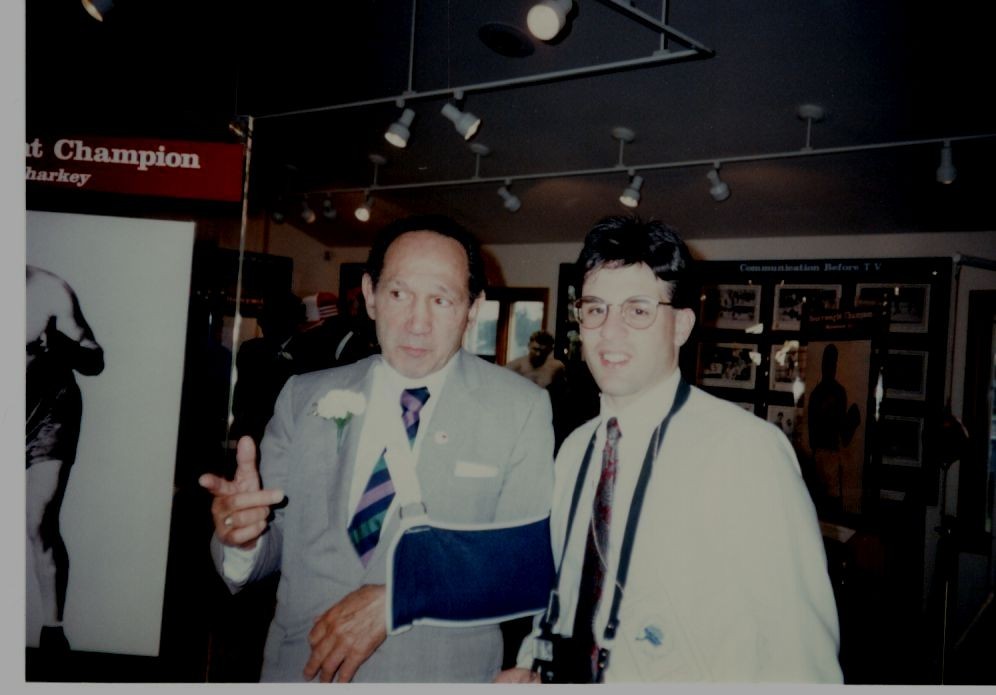
Alex Rinaldi with the great former 2-time featherweight champion Willie Pep. (Photo by John Rinaldi)
The book can be purchased in paperback and Kindle versions on Amazon, in paperback and Nook Book versions at Barnes and Noble bookstores, Barnes and Noble’s website, and at bookstores around the globe.
___________
The USA Boxing News Book Review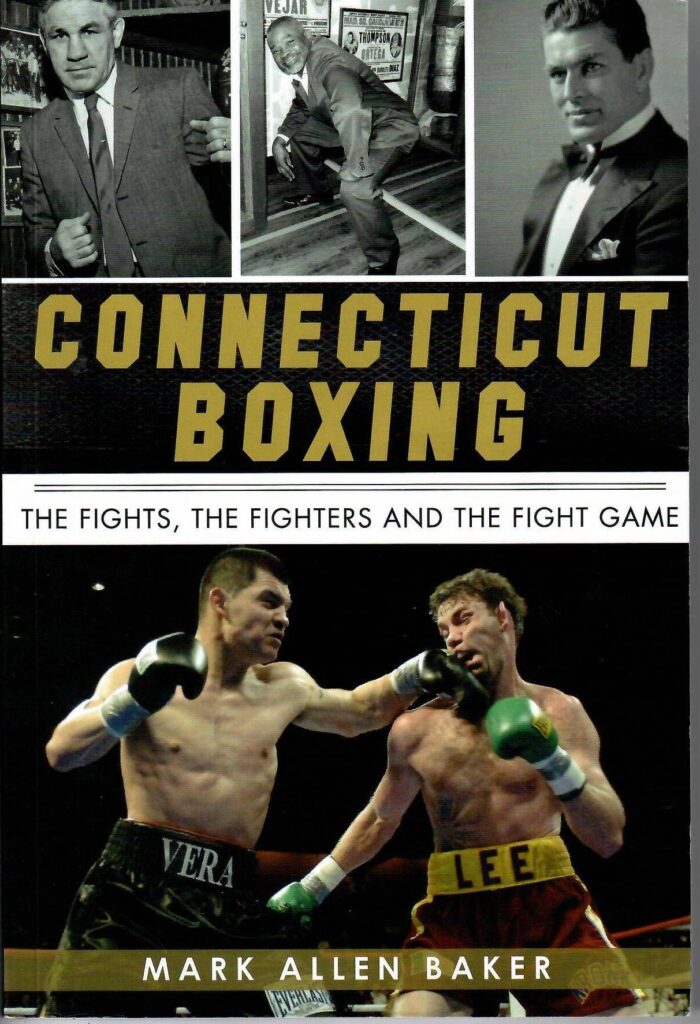
By Mark Allen Baker
The History Press (www.historypress.com) – 174 pp
Reviewed by John Rinaldi and Alex Rinaldi
Just as the shutters begin to open and homes are swallowed up by the relaxing rays of sunshine, Mark Allen Baker has written another terrific book to enjoy during the balmy late Spring and Summer days. His new book, as clearly stated in the title, focuses on the memorable fights that took place in the Constitution State, along with the gutsy pugilists who either plied their trade with their fists, or settled into the New England state to live out the remainder of their days. Baker is an expert on Connecticut prizefighting, which is why he is a member of the Board of Directors of the esteemed Connecticut Boxing Hall of Fame. If one has not had the pleasure to read one of Mr. Baker’s past works, they include Lou Ambers, The World Colored Heavyweight Championship, 1876-1937, The Fighting Times of Abe Attell, Between the Ropes at Madison Square Garden, and Battling Nelson – The Durable Dane. His most recent book is CONNECTICUT BOXING – THE FIGHTS, THE FIGHTERS AND THE FIGHT GAME.
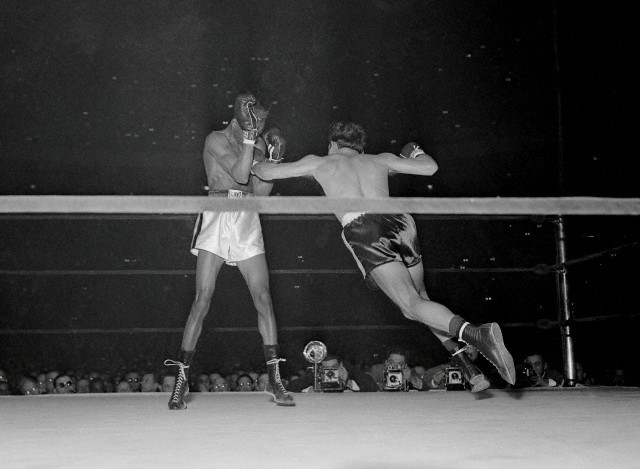
Willie Pep (R) throws a lunging left hook at Sandy Saddler (L) as Sandy Saddler covers up in 4th round of their featherweight title bout at Madison Square Garden on February 11, 1949. Pep won unanimous decision.
In yet another terrific book, the author brings alive a bygone era as he has chapters beginning with fights in the Nutmeg State prior to 1900 and goes all the way to the present period where two magnificent casinos, the Mohegan Sun and Foxwoods Resort, have given the sport of boxing a big boost.
The book has fascinating stories featuring not just the famous Connecticut fighters such as Gene Tunney (who did not fight in Connecticut, but lived the remainder of his life there), Jack Delaney, Willie Pep, Marlon “Magic Man” Starling, Louis “Kid” Kaplan and Battling Battalino, but also pugilists like Giulio Gallucci (better known as Johnny Duke), Gaspar Ortega, Lou Harwick (The Cocoa Kid) and Lou Bogash (known as The Blonde Italian), among many others.
The chapters on Battalino, Starling and Kaplan are simply wonderful where a reader gets textbook stories on those prizefighters as their careers are excitingly chronicled from their amateur successes all the way to their rising through the ranks to finally becoming World Champions. Mr. Baker never takes the short way out in just giving a laundry list of accomplishments, he instead paints a portrait in vibrant colors of the spectacular fights those combatants engaged in. It is as if his pen was dipped in lighting as the reader is transported ringside to such memorable contests.
The author brings an insight to the legendary Willie Pep that was a treasure chest of stories. Pep was not an easy person to interview because he told jokes and skimmed over his career. Mr. Baker, however, had the former featherweight king open up on his ring strategy, his historic battles with Chalky Wright and Sandy Saddler, and Pep’s 1947 plane crash that only kept the fistic great down for five months, and that is after being damaged with a cracked vertebra, chest injury and broken leg!
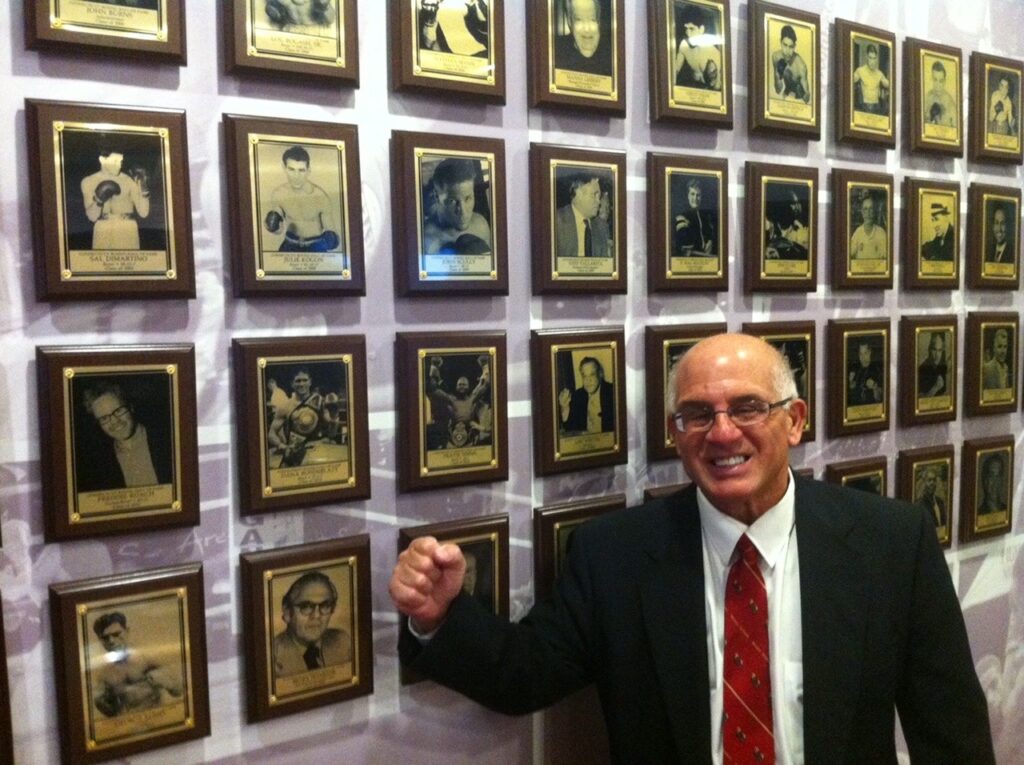
2017 CONN. BOXING HALL OF FAME WITH THE USA BOXING NEWS EDITOR-PUBLISHER JOHN RINALDI AT THE PLAQUES OF INDUCTEES.
When Pep spoke about the smartness of his manager Lou Viscusi, he modestly explained that Viscusi was careful about picking “the right guy” for him to fight. In the prime of his ring career, Pep seemed to face and beat everyone out there, so there were hundreds of “right guys” he took on! The chapter on Pep is revealing and informative. That is what a book is supposed to be about. Pep has been featured in tons of books, but this is the first one where the reader gets to know inside Pep’s head and admire him even more. That is a reflection on the kind of writer Mr. Baker is.
When reading a book, you want to be informed about boxers that have not been detailed too much in the past. The sport of boxing is filled with many thrilling fights, and the author writes about nearly every one of the greatest fights in Connecticut history.
The author does not just shine the light on the prizefighters, he has a chapter on the Great Venues where historic contests took place. Mr. Baker is always one to find a gold nugget of information. When chronicling about the Morgan G. Bulkeley Stadium in Hartford, there is a mention that the building was known as the location of the immortal Babe Ruth’s final appearance in a baseball game, when “The Sultan of Swat” engaged in a charity game on September 30, 1945. That is great stuff to read!
When Mr. Baker turns to the fantastic battles that took place in the casinos, he not only provides the best description of the spectacular Arturo Gatti-Micky Ward from May 18, 2002, but of many more bouts that feature the likes of Roy Jones, Vinny Pazienza, Dana Rosenblatt, James Toney, Mike McCallum, Phillip Holiday, Lennox Lewis, Evander Holyfield, Zab Judah, Devon Alexander, among a plethora of others.
One fight that we attended that is showcased in dazzling detail is the April 16, 2011, slugfest at Foxwoods featuring Victor Ortiz and Andre Berto with the WBC welterweight title on the line. Reading Mr. Baker’s saga of the contest brought to life that amazing fight that we covered at ringside. Sometimes you tend to forget as the years go by some of the great fights you witnessed, so it was nice to relive that battle again through the dashing words of the author.
Gasper Ortega -R- wallops former 2-division champ Carmen Basilio in their close 1961 bout where Basilio won.
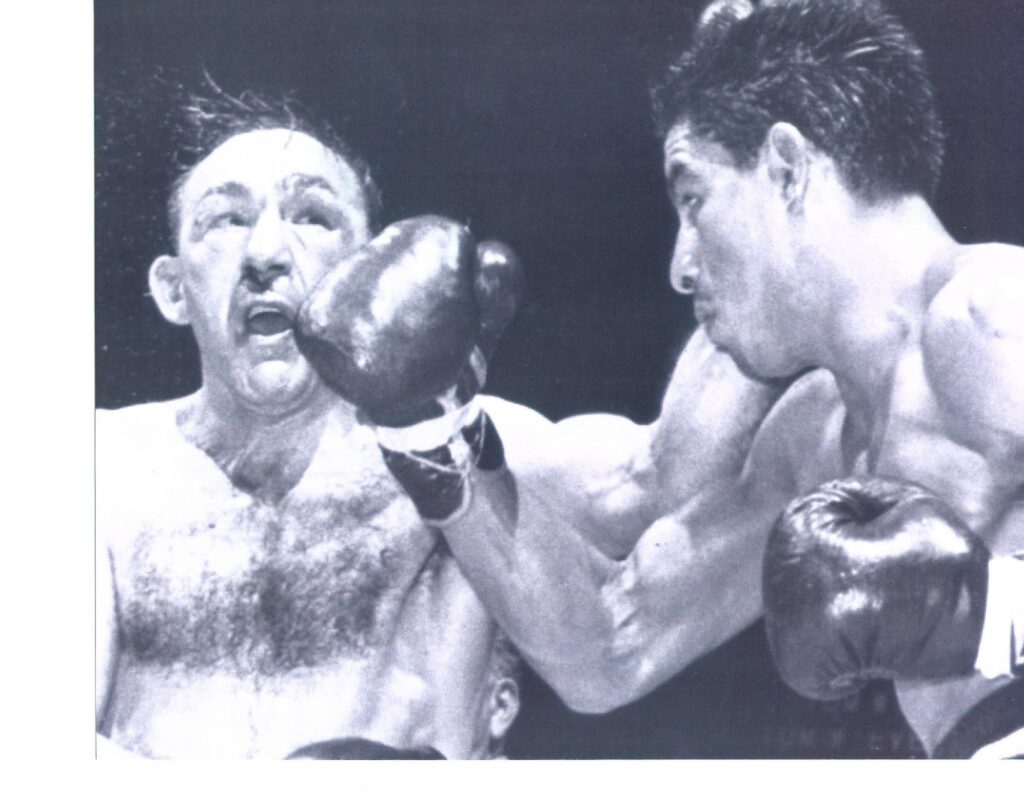
Gasper Ortega -R- wallops former 2-division champ Carmen Basilio in their close 1961 bout where Basilio won.
Mr. Baker chronicles the top twenty boxing matches in the Mohegan Sun history (1996-present) and Foxwoods Resort (1992-present).
The casinos provided boxing with an historic comeback and has delivered 30 years of thrills that transformed Connecticut into one of the top states for “The Sweet Science” out there.
Mr. Baker concludes the book on the formation of the admirable Connecticut Boxing Hall of Fame that is located at the Mohegan Sun, which is a credit to the sport.
Chapter through chapter of this publication the reader will be entertained and educated on the fisticuffs that have occurred in the state of Connecticut. It is a phenomenal book.
This book is HIGHLY RECOMMENDED!
The book can be purchased in paperback and Kindle versions on Amazon, in paperback and Nook Book versions at Barnes and Noble bookstores, Barnes and Noble’s website, and at bookstores around the globe.
_________
The USA Boxing News Book Review

By Mark Allen Baker
McFarland & Company, Inc., Publisher – 231 pp
Reviewed by John Rinaldi and Alex Rinaldi
Mark Allen Baker is writer that takes on subjects that most people do not think of writing about and weaves a captivating narrative. Not surprisingly, Baker also does not shield away from difficult topics as seen in his wondrous past books as: The World Colored Heavyweight Championship, 1876-1937, The Fighting Times of Abe Attell, Between the Ropes at Madison Square Garden, and Battling Nelson – The Durable Dane. His most recent book is LOU AMBERS – A Biography of the World Lightweight Champion and Hall of Famer.
While we consider ourselves very knowledgeable boxing historians, Mr. Baker somehow always seems to amaze us with information that we were not readily familiar with. One such subject was the background and life of former two-time lightweight king Lou Ambers.
Maybe it is because he is overshadowed by being the final crown acquired by the immortal Henry Armstrong in his historic quest for Boxing’s Triple Crown. In that bout, Armstrong defeated Ambers on August 17, 1938 to win the Lightweight championship, while at the same time reigning as the World’s Featherweight and Welterweight title holders. Because of that, Ambers’ place in the minds of boxing fans may have become obscured a bit.
Thankfully, Mr. Baker has come along to resurrect Amber’s incredible accomplishments and makes a solid case why he was probably one of the greatest lightweights of all time, while at the same time being overtaken by the gigantic shadow of Henry Armstrong.
Baker begins the book by giving a brief history of Bootleg Boxing in New York State. In the 1920s and especially into the Great Depression era of the 1930s, individuals down on their luck, or looking to make a few quick bucks, would fight in bouts that were not recognized by the New York State Athletic Commission as well as often fight under various aliases. When times were tough and literally no jobs were to be found, there was never any shortage of men using their fists as tools to eke out a living.
One such individual was Luigi Giuseppe D’Ambrosio, who was born on November 8, 1913 in Herkimer, New York. Learning boxing from the local priest in his town, Luigi, who was known as Lou, took on the fistic profession and in doing so, like Jack Dempsey before him, rode the rails like a hobo to get to various destinations throughout New York State to earn money boxing. Using a various number of aliases, the two most common were Otis Paradise and Lou Ambers, Lou kept chugging away fighting and beating anyone put in front of him in the ring. Once he proved that he was much more talented than to be fighting in bootleg promotions, he eventually entered the big-time world of professional boxing in New York City.
Soon he met up with manager Al Weill, who would later be famous as the manager for the immortal heavyweight champion Rocky Marciano, and Ambers began to rise through the ranks fighting just about every top lightweight in the country.
In doing so, the author paints a vivid picture of boxing in the 1930s laced with such greats as Tony Canzoneri, Barney Ross, Jimmy McLarnin, “Baby” Arizmendi, Lou Jenkins, Fritzie Zivic, Pedro Montanez, and Henry Armstrong. All of those fighters come to life in vivid detail where the reader can get a glimpse of each fighter’s career, personality and style.
Mr. Baker has that knack for detail where he places his readers into a portal through time and deposits them ringside for memorable battles. He also makes a reader feel that they are also in a smaller smoke-filled arena watching Ambers fight local boxers, journeymen, club fighters and hungry contenders. It is a fascinating journey the author takes one through. Mr. Baker through his relentless and extensive research has established for the reader a direct pulse into the boxing landscape that prevailed in that long ago period.
Ambers (89-8-7, 2 NC, 28 KOs) was not a KO artist, but he was clever boxer, had terrific footwork, possessed a solid wallop, and threw the type of blows that can rip open an opponent’s face.
It was a hard road back then for it is was not uncommon to engage in 15-20 fights a year to work your way up the ladder to a title shot, or at least big paydays.
Interestingly enough, Ambers’ idol in early career was the great Tony Canzoneri, and lo and behold, it would be that same fighter whom he would face on September 3, 1936 for the lightweight championship. Although Lou would come up short in his first crack at the throne, he would learn a lot from the man who won titles in 3 divisions and held a total of 5 world titles.
Lou would eventually defeat Canzoneri for lightweight championship honors, but it would take fighting 1-2 fights a month to work his way up the ladder for a rematch. Vividly recounting these facts, the author provides vivid detail on Ambers’ second march to the title to his winning the championship and becoming the hero to his town in Herkimer, New York – fighting under the nickname of “The Herkimer Hurricane” throughout his storied career.
Mr. Baker not only takes the readers into the life of a world champion and all of the pressures there is to not just keep his title, but he also identifies and brings to life what Amber did to remain sharp with numerous non-title bouts.
The author also builds up the emergence of Henry Armstrong as he terrorizes everyone from the featherweight division, all the way up to the welterweight class. Like a true champion, Ambers shows no fear on taking on such a fearsome opponent. Although he is battered in his first meeting with Armstrong, Baker chronicles Lou’s road back to redemption in the rematch with his nemesis.
The author does impeccable research where he is like an investigator looking for missing person. He looks under every rock, digs into old local papers, talks with surviving relatives, all in an effort to give his subject and his career a full dimensional depiction.
We loved this book and walked away with a new found respect for Lou Ambers. Sadly, while the great lightweight king died on April 25, 1995, he did live to see himself inducted into the National Italian American Sports Hall of Fame in 1978, the World Boxing Hall of Fame in 1982, and the International Boxing Hall of Fame in 1992.
This book is HIGHLY RECOMMENDED!
The book can be purchased in paperback and Kindle versions on Amazon, in paperback and Nook Book versions at Barnes and Noble bookstores, Barnes and Noble’s website, and at bookstores around the globe.
_________
The USA Boxing News
Book Review
The World Colored Heavyweight Championship
1876-1937
By Mark Allen Baker
McFarland & Company, Inc., Publisher – 250 pp
Reviewed by John Rinaldi and Alex Rinaldi
One of our favorite authors, Mark Allen Baker is back at it again writing a fascinating book on a subject that has barely been chronicled in the annals of boxing.
In the past, Baker has written such wonderful boxing books: Battling Nelson – The Durable Dane, The Fighting Times of Abe Attell, and Between the Ropes at Madison Square Garden. His recent treatise, The World Colored Heavyweight Championship, 1876-1937, just may be his best.
Of all the professional sports, boxing has the best history of giving minorities opportunities to compete in the pro ranks and even get chances to win a world championship. While being denied chances in such sports as Major League Baseball and later the National Football League, African American athletes have thrived in boxing. While black pugilists were given shots at the lighter weight titles, the chance to win the heavyweight crown was cut off from them due to the reigning champions at the time drawing “The Color Line” to avoid facing them in the ring.
Because of the black heavyweights being denied at the World Heavyweight Championship, Mr. Baker has taken it upon himself to bring glory back to the hard-luck boxers by telling the tale of the thrilling history of the World Colored Heavyweight Championship that took place from 1876 to 1937, starting with its first champion Charles C. Smith in 1876 and concluding with Larry Gains in 1937. Besides the history of the World Colored Heavyweight Championship, the author gives the readers biographies of all the top black fighters of the period. As the years go by, even famous fighters are relegated to forgotten shadows of the past, but when dealing with pugilists who were denied title opportunities in their career, their names are buried even deeper in oblivion.
Fighters like George Godfrey, Bob Armstrong, Peter Jackson, Frank Childs, George Byers, “Denver” Ed Martin, Sam McVey, Joe Jeannett, Sam Langford, Harry Wills, “Big” Bill Tate, Larry Gains and Cecil “Seal” Harris, are among the names that come to life for the reader to discover through the pages of the author’s informative and wonderful book.
Mark Allen Baker has that rare knack of sending the readers back in a Wellsian Time Machine into the musty arenas of yesteryear to bear witness to stirring pugilistic battles. We felt as if we were ringside when Sam Langford and Harry Wills were ripping into one another in their torrid fistic counters together.
Baker takes no prisoners in his indictment of the white Heavyweight Champions who used the “Color Line” to cover up their own racist ideals, or just plain cowardice.
Colored Heavyweight Champion Jack Johnson was the first black fighter to finally achieve a shot at the World Heavyweight Championship. On December 26, 1908 at Sydney Stadium in Sydney, New South Wales, Australia, the black challenger Johnson brutally finished off the reigning title holder Tommy Burns in Round 14, of a scheduled 20-rounder to capture the World Heavyweight Championship.
It took Johnson nearly a decade to get the shot and one would think that the “Color Line” and the World Colored Heavyweight Championship would come to a close, but that was not the case, since Johnson had no desire to defend his laurels against of his black brethren. Even though Johnson had defeated the likes of Sam Langford, Sam McVey and Joe Jeannett in earlier bouts, he was not ready to risk such a matchup with his beloved title at stake. Because of Johnson himself drawing the “Color Line” to avoid talented black contenders, his reign not only caused the continuation of the World Colored Heavyweight Championship, but gave rise to the World White Heavyweight Championship.
Johnson eventually did give a black fighter a chance, Battling Jim Johnson, the black pugilist from Memphis, TN, but the challenger had already been beaten by Sam Langford, Joe Jeanette and Sam McVey, three men Jack Johnson refused to meet. During the Jack Johnson-Battling Jim Johnson bout held at the Elysee Montmartie in Paris, France, the champion possibly broke his arm by falling in the third round and barely managed to eke out a 10-round draw against Johnson.
After that match, Johnson would not give another black fighter a title opportunity.
When Jess Willard KO’d Johnson in 1915 to win the World Heavyweight Championship, the World Colored Heavyweight Championship remained, while the World White Heavyweight Championship disappeared.
While Jack Dempsey was ripping through the all of the heavyweight challengers, except the black ones, the author recalls a fight at Madison Square Garden in 1918 when Jack Dempsey’s opponent Joe Bonds reported sick to fight the future champion, so Joe Jeannette, who was meeting Kid Norfolk on the same card, volunteered to fight Dempsey instead. As 8,000 fans urged Dempsey to take the fight, Dempsey’s manager Jack Kearns announced that his fighter would box any white man in the world, but would not meet a Negro, which had the fans booing loudly. Author Baker made a telling remark in the book, when he stated that “Living a dream with no opening bell was never fun.”
The next dangerous black heavyweight to rise through the ranks was Harry Wills. When Jack Dempsey dethroned Willard, Wills tried to get Dempsey to defend his laurels against him. Wills not only defeated most of the best black fighters around, he beat all the top white ones, too.
Later when Dempsey would say that he would give a black fighter a title shot, he soon would change his mind. Another funny quip from the author was that, “Only a few days later (when Dempsey said he would be willing to fight Harry Wills), whose contradictions were as common as sawdust in a lumber mill, denied he would meet Wills.”
In all due respect to Dempsey, most of the blame should go to his manager Jack Kearns. When Dempsey fired Kearns in 1925, he did sign to fight Harry Wills, but promoter Tex Rickard wanted nothing to do with a black/white match-up, due to the violence that occurred after his promotion of Jack Johnson’s destruction of James J. Jeffries in the boiling sun of Reno in 1910. Unfortunately, the span of fifteen since since that Johnson-Jeffries bout still somehow wrangled in Rickard’s psyche. The problem was Rickard foolishly remembered the bad part, not the good part – which was the fact was that the Jeffries- Johnson fight was one of the most lucrative boxing promotions of all time, and that the Jack Dempsey in 1925 (who was still in his prime) was a far cry to the pathetic aged Jeffries of 1910.
Through the years, when the talented black fighters did not get title shots against the white champions, they kept busy by repeatedly fighting each other for what appeared to be about a dozen times each, and also boxed the usual pool fighters who were available to fight at a moment’s notice.
The author writes poignantly about the frustrating predicament the prominent black fighters had to deal with through the decades. Thankfully, his superb research brings to life each black boxer’s major battles, not only against each other, but against the white contenders who were not afraid to face them.
As the years quickly passed by, each black fighter would see their skills erode and his place taken by another young buck.
In retrospect, the three biggest match-ups that should have been made between a black challenger and a white heavyweight champion, would have ultimately been much more beneficial for the white champion. In 1892, John L. Sullivan was out of the ring for three years and he would have been better off fighting a big fighter who would have stayed in front of him and traded blows in Peter Jackson, instead of a fleet-footed James J. Corbett, who was fast and darted in an out, making the old champion miss. Had he fought Jackson, Sullivan would have had an excellent chance to win that one.
Then there was James J. Jeffries from 1902 to 1906. Jack Johnson was a great fighter, but not a busy puncher, and certainly did not possess enough of a mighty wallop to take down a prime Jeffries. If Jeffries would have defended his laurels against Johnson in his championship years, it is doubtful that he would not have edged out the black challenger just on sheer aggression over 15 or 20 rounds.
That brings us to Jack Dempsey in 1925 or 1926. In 1926, Dempsey faced Gene Tunney, a man who unapologetically avoided black contenders, and who built up his career fighting middleweights, light heavyweights, or guys who were already bludgeoned by Dempsey. Frankly, Tunney did not deserve a shot at the title, Harry Wills did. Wills had the style that Dempsey, who was just coming off a three-year layoff, could have better handled since Wills, unlike Tunney, would have come directly at the champion and was slow. Tunney, on the other hand, did not have the guts to trade with Dempsey, and just ran away and boxed from the outside.
More disturbingly, in the first Tunney fight, Dempsey came into the contest suffering from food poisoning and having to brawl during a torrential rain storm where he could not set his footing firmly to throw a hard punch, while Tunney just ran and piled up points. Wills certainly would have been a more competitive fight for Dempsey.
A month after Tunney defeated Dempsey, Harry Wills, 215, lost a 13th-round disqualification against top contender Jack Sharkey, 188, before 45,000 at Brooklyn’s Ebbets Field. Wills was taking a beating throughout the bout by Sharkey until he he repeatedly back handed his way to a disqualification loss.
Then on July 13, 1927, again at Ebbets Field, Harry Wills, 215, was KO’d in 4 rounds by the Spanish contender Paolino Uzcudun.
So if fighters like Sharkey and Uzcudun, who clearly did not have the punching power of Jack Dempsey could finish Wills off, it makes sense that Dempsey could not just have done the same thing – namely KO Wills, but probably sooner.
In reflection, and using 20-20 vision, the three heavyweight champions who famously drew the “Color Line” actually made the biggest blunder of their careers. The worst, of course, was Jeffries, who came out of a five-year retirement, and lost nearly 100 pounds, only to be butchered in 15 rounds by Jack Johnson on July 4, 1910.
That loss was catastrophic to Jeffries’ legacy, because it not only ruined his reputation and career, it also demolished and set to flames, essentially overnight, his position as one of the greatest heavyweight champions of all time.
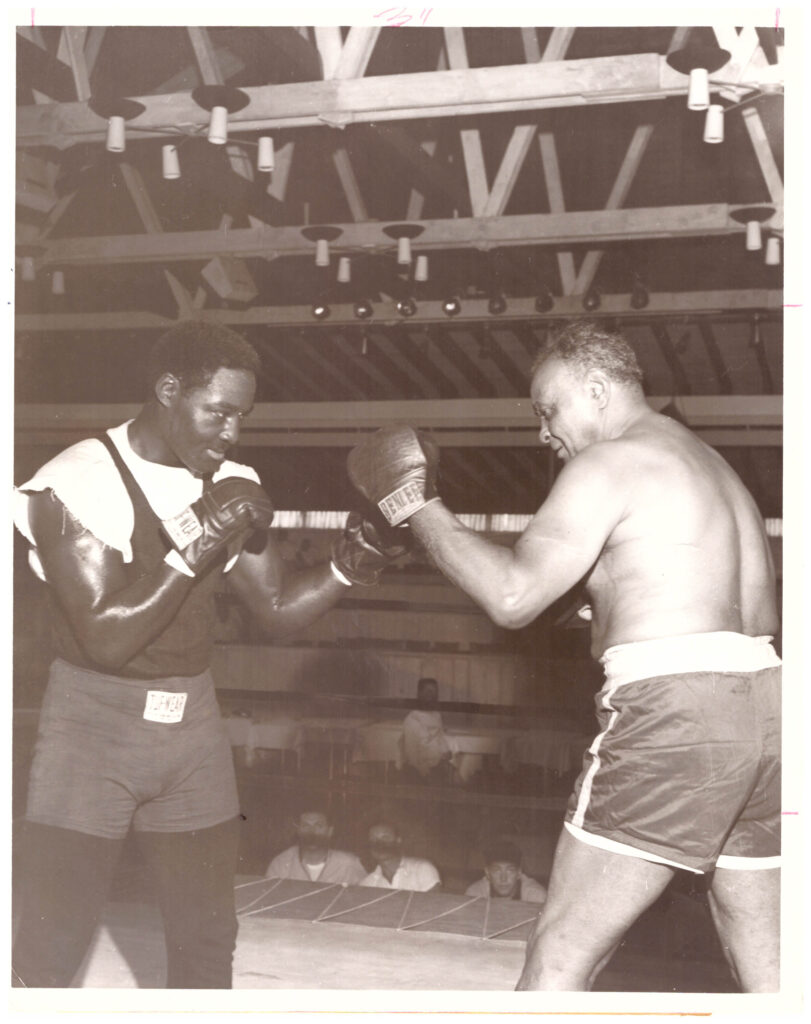
Harry Wills trains with former heavyweight king Ezzard Charles for his 1954 fight with Rocky Marciano.
The author wraps up with Larry “The Toronto Terror” Gains, who had the distinction of being the last recognized holder of the World Colored Heavyweight Championship. Gains was a tremendously talented fighter who KO’d future heavyweight champion Max Schmeling in two rounds on August 28, 1925, and later captured a 10-round decision over another future heavyweight king, Primo Carnera, on March 30, 1932. Those are two wins that Gains notched over two future great champions!
Although the fighters chronicled in the book, with the exception of Jack Johnson, never saw their day in the sun in a World Heavyweight Championship contest, they did, however, have the opportunity to earn large paychecks in fights, and certainly made more more money than any other black athlete, or even most successful black professional men, could have ever earned during that same period.
It also must be noted that most heavyweight champions of that era barely defended their title against anyone, black or white. It was not until Tommy Burns became champion in 1906 that boxing saw a heavyweight king make numerous defenses of his crown. Therefore, it is not surprising that Burns was the man to cross the “Color Line” and grant Jack Johnson a world title shot.
Mark Allen Baker’s superb book is filled with such wonderful stories and profiles of brave men who never gave up their dream and persevered with all of the odds against them.
The terms “hero” or “trailblazer” get tossed around a lot, along with “justice warriors” today, but Mark Allen book is filled with men who used their fists and fought with honor who were the real deal. Their stories deserve to be told, and Mr. Allen rises up to the task with flying colors.
This book is HIGHLY RECOMMENDED!
The book can be purchased in paperback and Kindle versions on Amazon, in paperback and Nook Book versions at Barnes and Noble bookstores, Barnes and Noble’s website, and at bookstores around the globe.
____________
The USA Boxing News
Book Review
CRAZY FOURTH
How Jack Johnson Kept His Heavyweight Title and Put Las Vegas, New Mexico on the Map
BY TOBY SMITH
University of New Mexico Press
Reviewed by John Rinaldi
Of all of the heavyweight champions of the past, the name of Jack Johnson (1878-1946) is one of the most memorable. He not only became the first black man to win the World’s Heavyweight Championship, he was a colorful personality and engaged in one of the biggest fight promotions of all time when he destroyed the come-backing James J. Jeffries on July 4, 1910. That fight attracted a huge crowd of 15,760 and the films of the contest were shown across the globe.
Author Toby Smith’s book CRAZY FOURTH, is a humorous story of Johnson’s next defense two years later against “Fireman” Jim Flynn (1879-1935) in a ring constructed in Las Vegas, New Mexico, known as “The Little Las Vegas” by most people.
Smith fills in the two years between the Jeffries bout and the Flynn defense by describing in detail what the heavyweight champion was participating in to make money off his title. Unlike many revisionists in writing history of a bygone era, Smith gives a clear depiction of Johnson and his popularity. Although he was black and racism obviously existed in some parts of the country, Jack Johnson was very popular with white and black fans. When he would do vaudeville shows and public appearances, most in attendance were mostly white.
As Toby Smith explains in the book, the two combatants in the July 4, 1912 fight were no strangers to each other since Johnson had KO’d Flynn on November 2, 1907 at Coffroth’s Arena in San Francisco.
By 1912, Johnson was eager to get back into the ring and promoter Jack Curley was anxious to promote a fight with the champion in the hopes that the title defense could be almost as popular as Johnson’s defense against Jeffries. The only problem, Smith chronicles, is that there were no opponents with the popularity or highly-esteemed reputation as Jeffries at the time. Since Johnson expressed no interest in fighting a talented black contender like Sam Langford and Sam McVey (two men Johnson did defeat already), the pickings were slim at the time to find a man who could take on the dangerous champion.
Promoter Curley came up with Jim Flynn because Flynn felt that he had improved over the past five years and that the challenger would fight for merely training expenses.
Once Flynn was signed up, Smith takes the reader on a roller coaster ride in the build up for the fight, the boxers’ training techniques and their personalities, and to the ultimate fight. There is humor, especially when the term “hog fat” comes up, along with a vivid description of Las Vegas, New Mexico and the goings on at the moment in time. Since many thought the bout would be a clear matchup, promoter Curley had his hands filled to come up with stories to excite fans to venture all the way to New Mexico to see the heavyweight championship contest.
Smith later writes about the post-fight accounts of each fighter where Johnson (54-11-7, 34 KO’s) would go on to make two more successful defenses of his heavyweight crown, until before brutally dethroned by Jess Willard on April 5, 1915 at Oriental Park in Havana, Cuba, by a bout ironically promoted by the same Jack Curley who handled the Johnson-Flynn fight.
As for Flynn (72-45-22, 56 KOs), he would never get another shot at the world title, but he would make history when he KO’d future heavyweight champion Jack Dempsey in one round on February 13, 1917. It was the only time the legendary Dempsey would be stopped in a boxing contest.
The only exception I found in the book was when Smith states that starting during the presidency of George W. Bush, there was a call to have Jack Johnson pardoned for his bogus conviction of the Mann Act. Surprisingly, besides Bush, the first black President of the United States, Barack Obama made no effort to pardon the fistic great, and it took the current President Donald Trump to pardon Johnson. With Sylvester Stallone (who played the character Rambo in four films), Deontay Wilder and Don King on hand at the White House, Trump gave Jack Johnson his well deserved pardon, but author Smith, possibly joking, said that Trump surely didn’t know who not only Johnson was, but who Rambo was. That was an unfair opinion since Trump is a big boxing fan and a member of the New Jersey Boxing Hall of Fame. The president knew very well who Johnson was and how unfair his conviction of the Mann Act was. Pardoning Jack Johnson was a wonderful effort by Trump.
Besides that little interlude, Smith’s book is a fun read that keep
s the reader’s attention to the point that before one notices the book is done.
Smith does a terrific job in writing in detail about a fight that has previously been given a minuscule passing reference in books on Jack Johnson, if even mentioned at all. That is an important task, because the author has unearthed a treasure that has been buried for over a hundred years.
The book (152 pp) is published by the University of New Mexico press, and can be purchased at: https://unmpress.com/books/crazy-fourth/9780826361431, which is the publisher’s website, along with Amazon, Barnes & Noble Bookstores and their website, along with many other bookstores in the United States and around the world.
This book is Highly Recommended.
____________
The USA Boxing News
Book Review
Reviewed by John Rinaldi
The legendary heavyweights of the late 19th Century have always held a fascination with me. The colorful figures of a bygone era engaged in fisticuffs at a time when the old-fashioned Victorian period was merging into the early modern Edwardian period is always interesting to read about. The heavyweights at the time were a talented lot who were prepared to fight with bare fists, or 3-oz gloves in bouts that were set for 3 rounds all the way up to infinity. 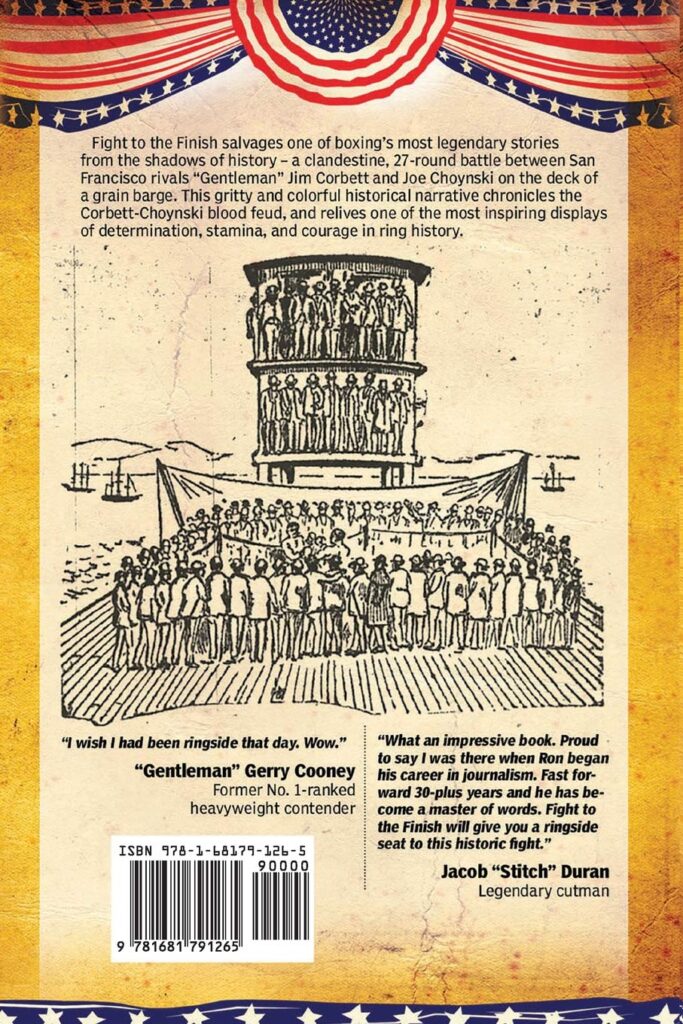
Author Ron J. Jackson took on enthralling subject in penning a tome about a pugilistic contest between two local San Franciso fighters. The notables on hand are Joseph Bartlett Choynski and James John Corbett, or better known as Joe “The California Terror” Choynski and “Gentleman” Jim Corbett. Both men were born in San Francisco, Choynski on September 1, 1866, and Corbett on November 8, 1868.
Jackson begins his book by describing the time period of the late 1880s in San Francisco in all its glorious detail. Of all the fighters in area, the two standouts were Choynski and Corbett.
At the time in San Franciso, boxing contests were either legal “exhibitions” at lavish Athletic Clubs, or illegal prizefights at such locales as cleared wooded areas, barns, farm fields, or just about anywhere a 16 ft. ring could be erected, including a barge!
Corbett and Choynski are depicted as fearless individuals who were afraid of no one. Each had their share of fans, which is why the city was anxiously awaiting the bout between the two gladiators.
The Author gives the reader an understanding of each pugilist. Choynski was known as a quiet, vicious two-fisted slugger, while Corbett was the brash, “Fancy Dan” fighter, who used his dazzling footwork and ring smarts, as much as his fists. Although Joe was considered the bigger puncher of the two, Corbett packed a wallop in his right hand and left hook, and had a spearing left jab that he smashed into the face of his foes.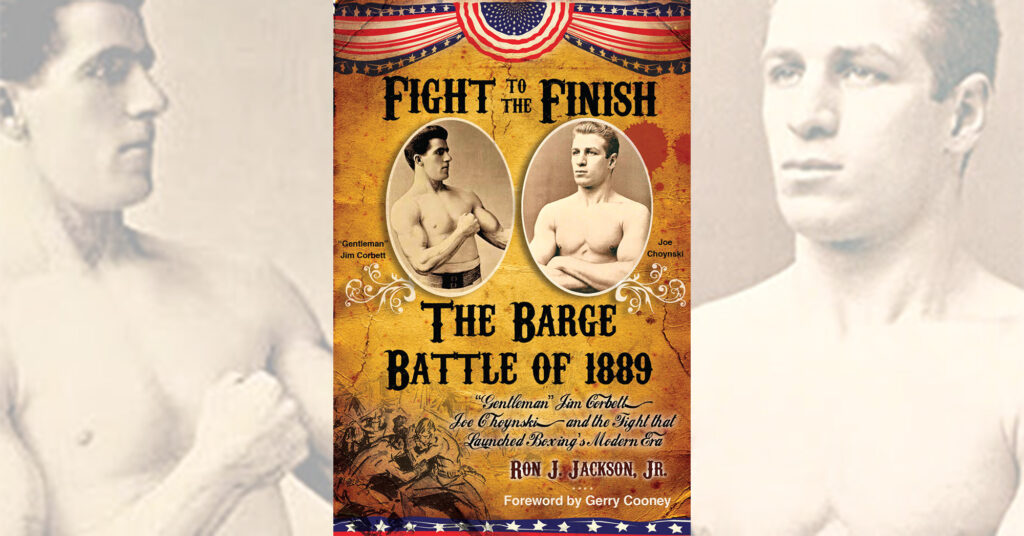
“Fight to the Finish – The Barge Battle of 1889” goes into all the events that lead the reader into the ultimate Armageddon. Along the way there is intrigue, excitement and humor. By the time the two combatants eventually meet at the barge in the quiet port town of Benecia, CA, the readers are on the edge of their seats awaiting the action.
The description of the ultimate battle that was scheduled as a “fight to the finish” – whereas its conclusion would be when one fighter was unable to continue the hostilities, is written in such striking detail that this reviewer felt he was on the barge witnessing one of the greatest and most brutal battles ever seen in the prize ring. This reviewer was aware of the fight, but through his intense research, the Author found so many nuggets of material that have never been written in a book before, which transforms the event into something really special, and even more blood-thirsty!
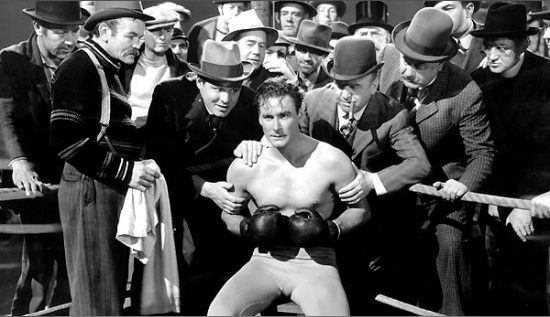
The movie Gentleman Jim from 1941 depicts the Barge Battle of 1889 with Errol Flynn portraying James J. Corbett.
After the memorable engagement, both fighters would go on to have illustrious careers. Corbett’s next big bout was on May 21, 1891 at the California Athletic Club in another “fight to the finish” against the top-ranked heavyweight challenger of the time, Peter “The Black Prince” Jackson, a Black fighter that reigning heavyweight champion John L. Sullivan avoided. Although Jackson, 197, was the bigger and more experienced fighter, Corbett, 185, took all Jackson could handle and was on the verge of winning before the bout was stopped after 61 grueling rounds and called a No-Contest.
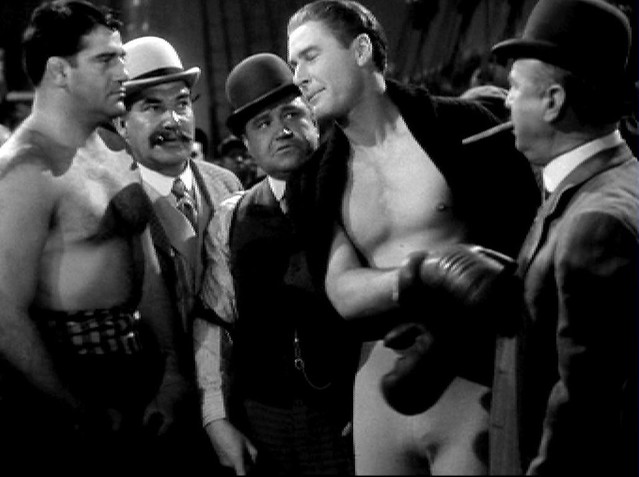 L-R George Lloyd and Errol Flynn depicting Choynski and Corbett during the Barge Battle scene in Gentleman Jim.
L-R George Lloyd and Errol Flynn depicting Choynski and Corbett during the Barge Battle scene in Gentleman Jim. On September 7, 1892 at the Olympic Club in New Orleans, LA, Corbett, 178, would KO the 4-1 favorite, heavyweight champion John L. Sullivan, 212, in 21 rounds to capture the title and become one of the most famous fighters of all time.
As for Choynski, although he never received a shot at the Heavyweight Championship, he did fight four men who would be future heavyweight kings. On November 30, 1897, Choynski, 167, took on James J. Jeffries, 219, in a 20-round contest at the National Athletic Club in San Francisco, CA. Although most felt that Choynski had done enough against the undefeated giant Jeffries, the bout was declared a draw. It was reported that Jeffries said that Choynski was the hardest puncher he ever faced and at one point of the fight, Joe drove a right hand that smashed into Jeffries’ mouth, driving his lower lip into his front two teeth, which needed a lip incision to ease the pain. Although Jeffries would KO Bob Fitzsimmons two years later to capture the Heavyweight Title, he would never give Choynski a shot.
Against two future heavyweight kings, Joe fought a 6-round draw against Bob Fitzsimmons on June 17, 1894 and a 6-round draw with Marvin Hart on November 16, 1903.
The biggest win of Choynski’s career was against the future heavyweight legend Jack “The Galveston Giant” Johnson. On February 25, 1901, Choynski KO’d Johnson in the third round with a right hand to the jaw in Johnson’s hometown of Galveston, TX, at the Harmony Hall.
Both Corbett and Choynski would later train Jim Jeffries for his comeback fight against heavyweight champion Jack Johnson that took place on July 4, 1910 in Reno, NV. In looking at the pitiful way Jeffries was beaten in 15 rounds by Johnson, it appears that both Corbett and Choynski could have given a stiffer challenge!
Although Corbett had died in 1933, in 1942, Warner Brothers came out with the film “Gentleman Jim” with Errol Flynn wonderfully portraying Corbett. Choynski, who would later die the following year in 1943, was able to see his bout with Corbett portrayed on the silver screen. The movie version of the barge fight was pretty well done with George Lloyd playing Choynski.
Mr. Jackson has done an amazing job with this book, which has turned out to be one of my all-time favorites. The story of the ferocious confrontation with all of its thrilling detail between two men who would become fistic immortals is a must-read for any boxing fan. It is simply unforgettable.
This book is HIGHLY RECOMMENDED!
The book can be purchased in paperback and Kindle versions on Amazon, at Barnes and Noble bookstores, Barnes and Noble’s website, and at bookstores around the globe.
____________
The USA Boxing News
Book Review
PROPER PUGILIST
ESSAYS ON THE MILLING SPORT
BY ROGER ZOTTI
Reviewed by John Rinaldi
There is no other sport like boxing where there is a plethora of fascinating stories and anecdotes to read about. Author Roger Lottie has formulated a page-turner book that is bursting to its seams with marvelous stories that will entertain fans of pugilism.
Roger Lottie is not only a talented writer, but he is a lifelong fan of the squared ring and a member on the Board of Directors of the esteemed Connecticut Boxing Hall of Fame. Mr. Zotti takes the reader on a journey over the past 100 years with stories, essays and anecdotes featuring the likes of Rocky Marciano, Gene Tunney, Jack Dempsey, Joe Louis, Archie Moore, Jess Willard, Max Baer, Jose Torres, Joey Maxim, Billy Conn, Tony Galento, Sonny Liston, Jake LaMotta, Billy Miske, Stanley Ketchel, Muhammad Ali and many other ring legends. The author even has a interesting passage concerning the immortal actor Errol Flynn while he was filming the boxing classic “Gentleman Jim” in 1942.
There is nothing more entertaining than reading a book jam packed with humorous tales of boxers and their memorable fights.
Besides famous fighters, Mr. Zotti injects the wisdom of his uncles Vincenzo and Cheech, who helped spark the fire of the author’s love of the fight game, along with the boxing fans he chatted with at Pepe’s Apizza.
The wondrous book is like chest filled with treasures of boxing yore. One such nugget is a story of Jack Dempsey making a phone call to Luis Firpo a few days after their classic 1923 heavyweight championship battle in the Polo Grounds. Dempsey apologizes to Firpo for belting him when he was barely back on his feet. The champ remarked over the telephone to Firpo, “You hit me so hard I didn’t know what I was doing. I was mixed up.” Firpo’s response was that there were three men in the ring, and if Dempsey didn’t know what he was doing, why didn’t he hit the referee?
That is great stuff and book has tons of these type of stories. This reviewer enjoyed every page of the book.
Those boxing fans who are also movie lovers, would like the passages featuring film greats like Frank Sinatra, Burt Lancaster, Richard Conte, Claud Rains and others.
This is the type of tome that a boxing fan can sit down on a comfortable chair, put his feet up and sit back and read an amazing book.
This book is HIGHLY RECOMMENDED!
The book can be purchased in paperback and Kindle versions on Amazon.
The USA Boxing News
Book Review
Between the Ropes at
Madison Square Garden
The History of an Iconic Boxing Ring,
1925-2007
By Mark Allen Baker
Reviewed by John Rinaldi and Alex Rinaldi
We are no strangers to the literary work of Mark Allen Baker. Baker is the type of tale-teller who tackles the sort of subject that few people would think of and then weaves a dramatic and historic narrative. In the past he wrote two outstanding boxing books: Battling Nelson – The Durable Dane and The Fighting Times of Abe Attell. With his new tome, Between the Ropes at Madison Square Garden, Baker has now formed a trilogy of books that a fan of boxing’s fabled history would spend endless enjoyable hours reading.
The new book is technically not about a specific fighter, or even a human being, it is about an inanimate object, which in this case is the historic boxing ring that was used in all of the fights at Madison Square Garden and, in the 1930s, also the Madison Square Garden Bowl from 1925 to 2007 – known as the City Ring.
Before getting to the ring, the author begins his story in 1871 with the early years of New York boxing and gets to the first Madison Square Garden that was built at East 26th Street and Madison Square. Two Madison Square Gardens were erected on that spot starting in 1879. In 1925 the famed promoter Tex Rickard got involved and built a new Madison Square Garden at 8th Avenue between 49th and 50th Streets, where it was nicknamed “The House That Tex Built” in honor of Rickard. That building was where the famed City Ring was first used. When the current Madison Square Garden, which is housed at 7th and 8th Avenues from 31st to 33rd Streets and sits atop Pennsylvania Railroad Station, was erected, the City Ring went with it and remained there until 2007.
Along the way from 1925 to 2007, nearly every man who held the World’s Heavyweight Championship plied his trade in that historic ring.
Mr. Baker brings those magical nights under the Madison Square Garden lights that bathed the City Ring with such boxing classics as Frazier-Ali I, Marciano-Louis, Louis-Walcott I, Carnera-Sharkey, Armstrong-Ambers I, Nova-Baer II, Soose-Abrams, Duran-Moore, Robinson-LaMotta I, Duran-Buchanan, Ali-Frazier II, Robinson-Armstrong, Pep-Saddler II, Graziano-Arnold (with vice president Harry S. Truman at ringside!), Marciano-LaStarza I, Baer-Carnera, Braddock-Baer, Holmes-Weaver, Sanchez-Nelson, Duran-Buchanan, Lewis-Holyfield I and too many more to mention. The author brings those memorable, smoke-filled evenings back to life with each thrilling page. From 1980 on, we covered at ringside nearly every major bout that is written in the book and Mr. Baker made us feel that he was sitting right besides us with the vivid descriptions of special battles and the excitement that was felt in the arena.
Every famous fighter in history is detailed one way or another in this fabulous book, along with those little known pugilists that fought on the undercards.
There is no boxing ring in history that has had more boxing legends grace its noted structure and the book is filled with a whirlwind of prizefight battles.
Mr. Baker gives a rousing description of the first bout ever televised in Madison Square Garden on April 4, 1941 featuring a rematch between former heavyweight king Max Baer and Lou Nova. Coincidentally, the author writes, that the first ever televised bout was the first fight between Baer and Nova on June 1, 1939 from Yankee Stadium. Unfortunately for Baer, he wound up on the losing end in both contests. The second bout marked the last time the legendary Max Baer would ever box, and it was right on the City Ring before a televised audience!
This is the type of book you can read chronologically, or just jump from one chapter to another and read stirring, rip-roaring and sensational boxing matches that graced the City Ring.
What the author does is bring the legends of the distant past and not too distant past back alive in all their splendor.
This is a special book that every fan of boxing’s rich history and its fabled warriors should have in one’s library. It is also the kind of manuscript that one would reread on and on.
The talented author has culminated his trilogy of terrific books with his best one yet that packs a mighty wallop!
This book is HIGHLY RECOMMENDED!
The book can be purchased in paperback and Kindle versions on Amazon, in paperback and Nook Book versions at Barnes and Noble bookstores, Barnes and Noble’s website, and at bookstores around the globe.



